July 30 - August 5, 2017: Issue 323
Early Pittwater Surfers: Palm Beach I
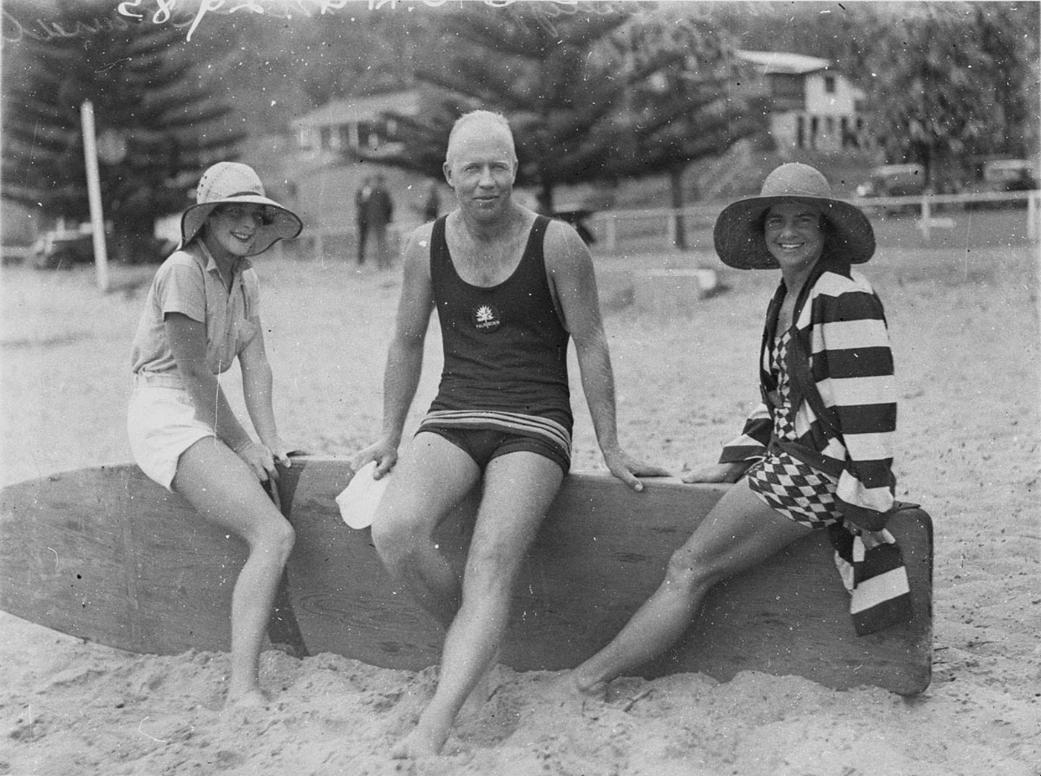
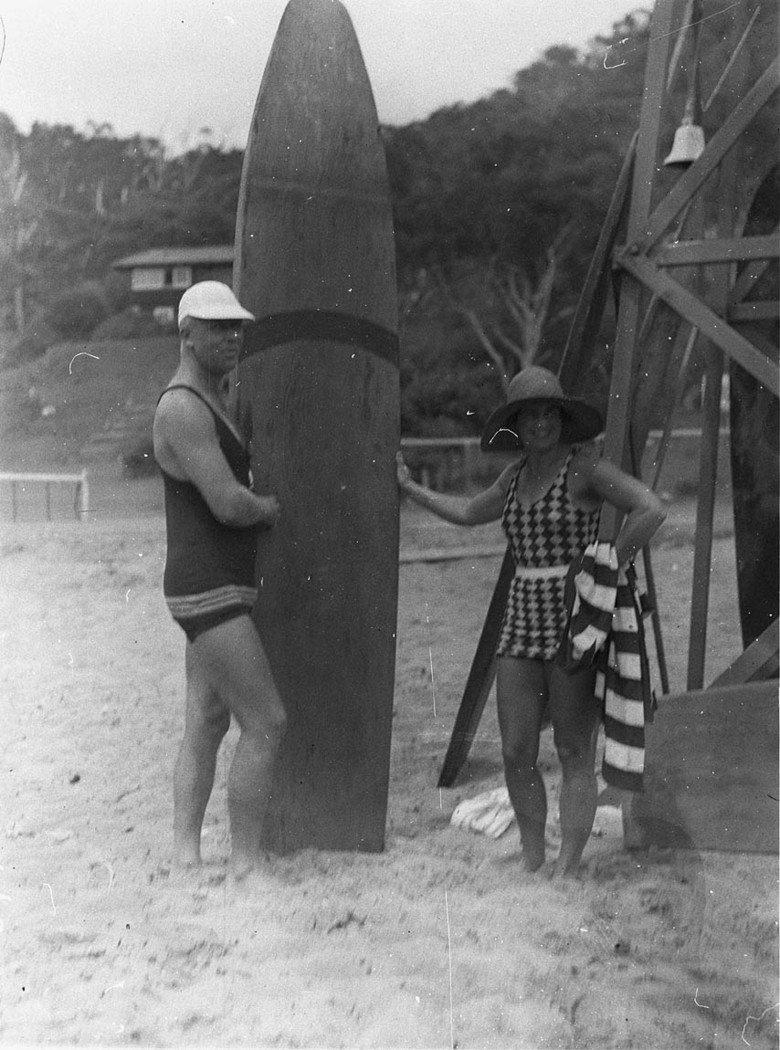
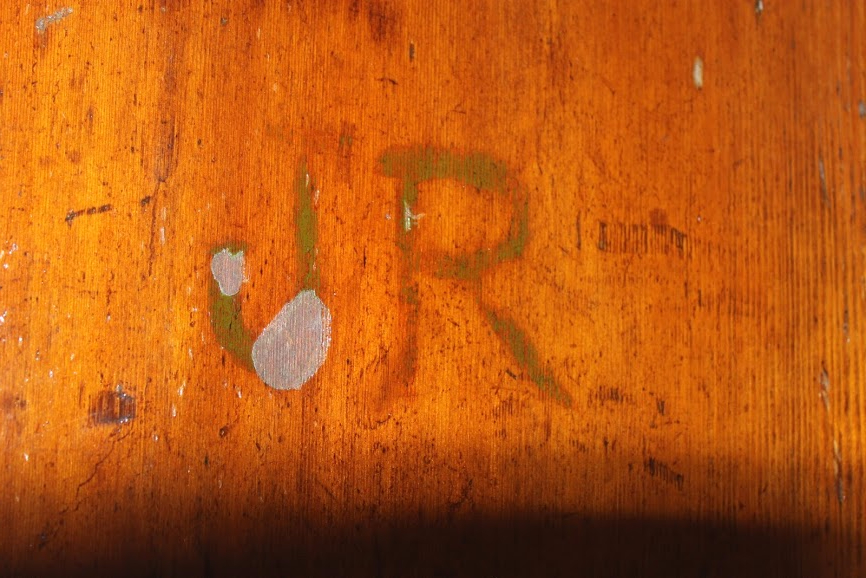
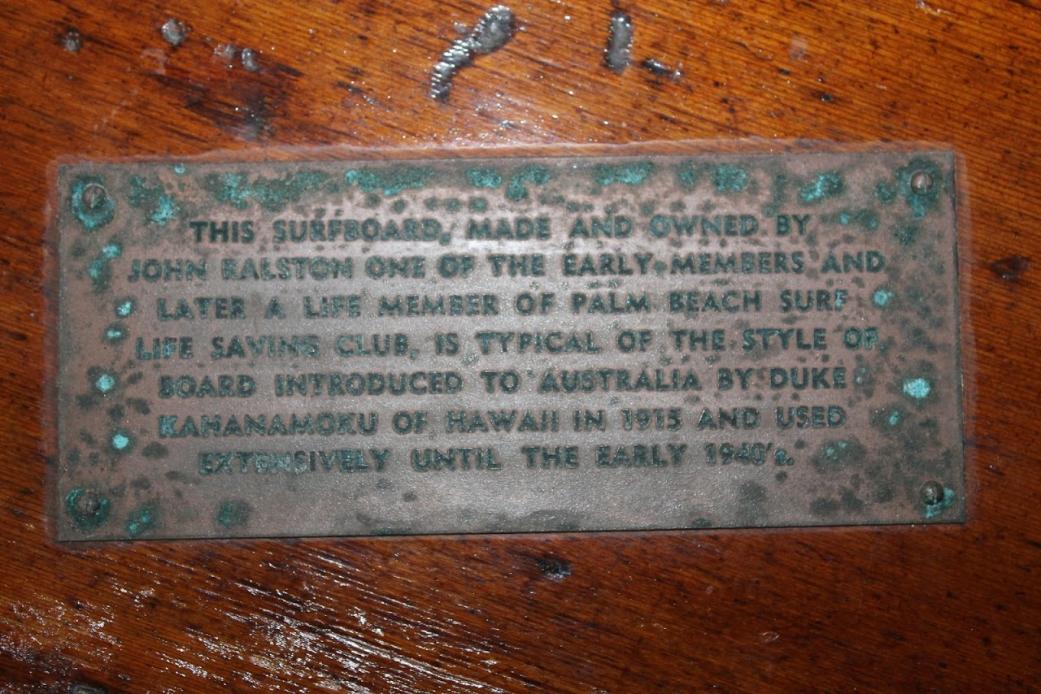
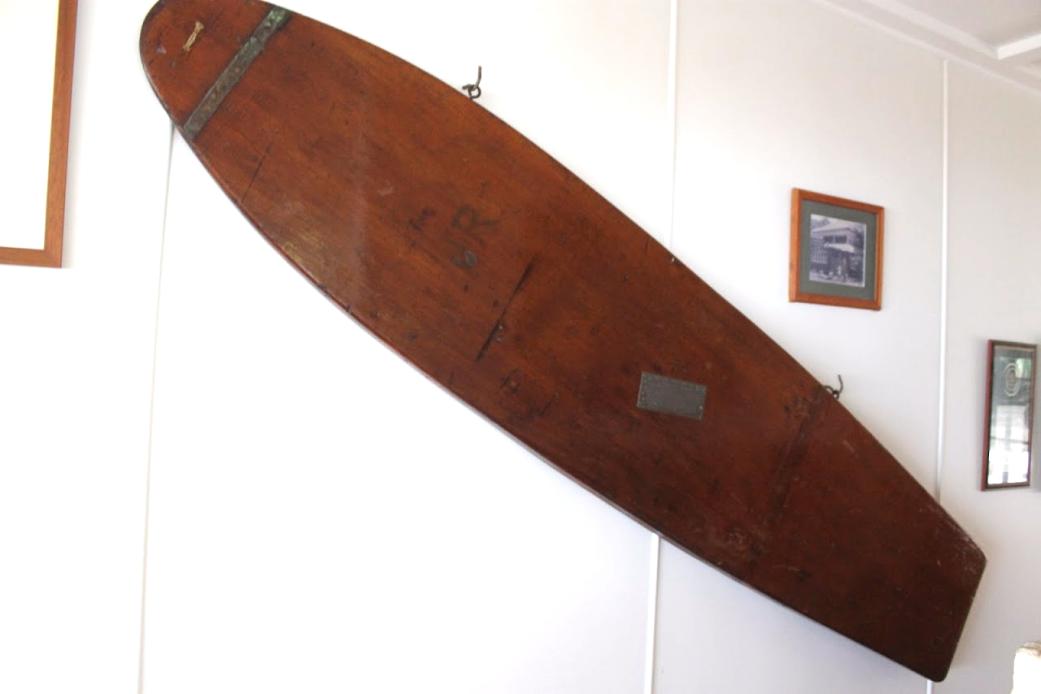
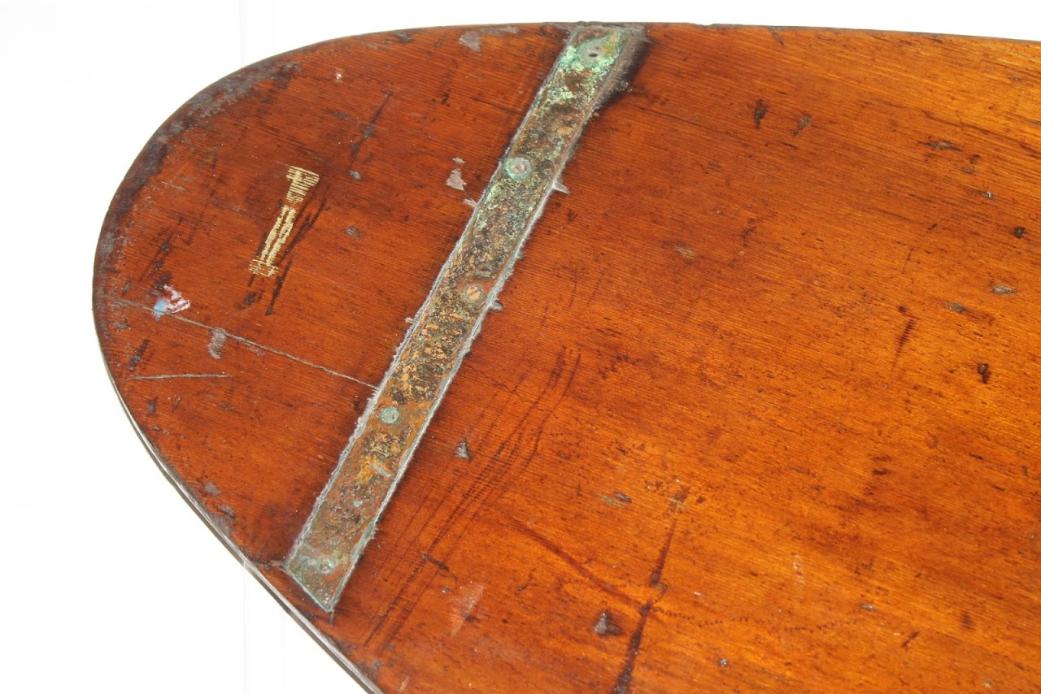
DUKE KAHANAMOUKU
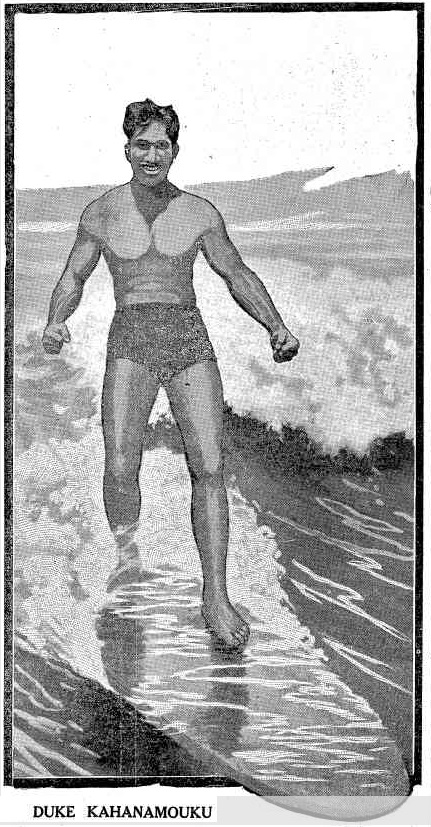
The marvellous Hawaiian, undisputed champion sprint distance swimmer of the world, some of whose natatorial feats are said to have astounded the fishes, as did the exploits of Pegoud, the French aviator, in the clouds, cause wonderment amongst the birds of the air. He is here seen performing one of his famous surfing accomplishments. This is not by any means his most daring achievement. Whilst dashing forward at an incredible speed, he stands on his head and does other things of an acrobatic description. Similar boards to the one he is shown using have been imported into Australia, but so far none of our surfing experts have been able to imitate his sensational deeds.
It is supposed, however, that the breakers that roll in on our shores are of a different formation, and not suitable for the purpose. All doubts on that subject would have been set at rest had Kahanamouku visited here this Summer, as was supposed to have been his intention. He has on several occasions expressed his willingness to come, but the time he originally offered to make the trip was regarded as inopportune by the officials of the Swimming Association who were carrying on the negotiations, and they fell through, owing to the date they suggested as a substitute clashing with the great water festival that is to be held at Honolulu on February 18 and 24 next. Visitors from all parts of the world have been known to go to Hawaii merely to witness Kahanamouku shoot the waves in the extraordinary fashion depicted above. DUKE KAHANAMOUKU (1913, December 14). Sunday Times (Sydney, NSW : 1895 - 1930), p. 20 (SUNDAY TIMES GLOBE PICTORIAL). Retrieved from http://nla.gov.au/nla.news-article126315151
SWIMMING: Kahanamouku and 100 yards championship. KAHANAMOUKU AND SURF BOARD. by Cecil Healy.
Representatives of the Press were invited to witness a private exhibition of surf-board riding by Kahanamouku at Freshwater on Thursday. It was to have been held the previous day, but the intention accidentally became public property and as several thousand people were attracted to the vicinity, Association officials decided to postpone it. Business considerations, unfortunately, prevented the writer from being present. Freshwater enjoys the reputation of being, on the whole, the best beach for shootable breakers, but the conditions, I understand, were far from being ideal for the purpose on that particular day.
The waves, for instance, were breaking too close to the shore to permit of a good 'run' being obtained, and, moreover, were of the 'dumping' variety; also the board itself, which was made locally, was not exactly what was required. It weighed in the neighbourhood of 100lb, whereas those in use at Honolulu, are only a quarter that weight. However, despite the disadvantages mentioned the Duke succeeded in assuming the perpendicular, and negotiating several shoots in his familiar poster attitude. On one occasion, whilst laying flat on the board, with a deft movement he swung the board right about, and proceeded backwards for a while before repeating the action and facing shorewards again. A number of our leading surfers were spectators of the display, and from what I can gather the general impression amongst them was that he did wonderfully well under the circumstances, but they were sure it merely amounted to an indication of what he is capable of doing under more favorable conditions. They have no doubt that when he has had opportunities of adapting himself to the vagaries of our surf, and strikes a suitable day, he will be able to.'do: things of a really sensational nature. The dextrous manner in which he handled the heavy board when taking it out through the breakers would appear to have greatly surprised the Sydney men.
Record entries have been received for the year's State championships. Two are to be decided at the initial carnival, which is to be held at the Domain Baths next Saturday afternoon lamely, the 100yds and 880yds. The Olympic champion, Duke Kahanamouku, and his brilliant travelling companion, George Cunha, are competing in the former event. It will be their first public appearance in competition. Incidentally, it will constitute the first occasion that an overseas champion has raced in Australia. The visitors will be opposed by the cream of the Commonwealth's sprint-distance swimmers. Australian record-holder Albert Barry will defend his title of 100yds champion of New South Wales W. Longworth, runner-up in both State and Australian 'hundred' championships last season, will also be one of those who will en-deavor to achieve for this State the honor of checking the Hawaiian's triumphant march. SWIMMING : Kahanamouku in 100yds Championship : (1914, December 30). Referee (Sydney, NSW : 1886 - 1939), p. 16. Retrieved from http://nla.gov.au/nla.news-article120278130
Two people likely to have witnessed or heard about these early surfing on a surf board attempts would be Sydney (sometimes spelt Sidney) McAuliffe, a Manly Life Saving Club and Manly Swimming club member to whom were attributed the saving of lives at Manly both before his WWI service and afterwards, and his sister Nora - who was born at Manly in 1906 after her father was took on a job at the Manly Gas company:
Presentations to Mr. J. A. McAuliffe. BY THE BOROUGH COUNCIL.
The Mayor and Aldermen of the Grafton Council held a special meeting on Monday night for the purpose of saying "farewell" to Mr. J. A. McAufliffe, who for the past eleven years has held the position of Manager and Secretary of the Grafton Lighting Coy., and who left yesterday to take a similar position in the Manly Gas Works. The Mayor occupied the chair and the aldermen present were Aldermen Bawden, Strauss, Johnson. Trent, Eggins and Shore. Mr. T. Pago, Council's Treasurer, and Mr. A. -McC. Labban, Council's Solicitor also occupied seats at the table. Apologies were received from Ald. C. Page, T. Richards, D. McFarlane and H. C. T. Maxted. The Mayor said he know Mr. McAuliffe perhaps better than most of those present and knew more of the valuable work he had rendered to the Council and the general public weal. He had always admired him as a mechanic. Not only in connection with the Water Supply, but long before, Mr. McAuliffe had rendered in valuable assistance to the Borough in respect to lighting end many other matters. He was net wholly sorry Mr. McAuliffe was going, for, though they were losing a valuable man, it meant promotion and gain to a deserving worker. He wished him a long and prosperous life. Aid. Bawden also spoke in highly complimentary terms of the unostentatious yet valuable work of Mr. McAuliffe. Many times they had sought his advice and profited by it. He felt he was losing a warm personal friend. Aid. Johnson spoke in a similar strain and testified to the splendid help to the Lighting Committee rendered by their guest. Ald. Eggins, as Chairman of the Works Committee, could speak from experience of Mr. McAuliffe's work. Many things his committee has carried out successfully had been suggested and directed by Mr. McAuliffe. Ald. Trent and Strauss also spoke in laudatory terms of the guest. They admired his skilful estimating and his discrimination in nil his work. Mr. J. G. Phillips, Council Clerk, said he had been brought into close touch with Mr. McAuliffe for years and if the latter's work had been rewarded by handsome sums of money it could not have been more faithfully or more perfectly carried out. His kind, unassuming manner had won for him the respect of every man, woman and child with whom he came in contact. _ The Mayor in presenting Mr. McAuliffe with an illuminated address, said he hoped it would adorn the home of McAuliffe's for centuries to come as an example to those that came alter their guest. Mr. McAuliffe rose amidst hearty applause and, in reply, said he thanked the Mayor and Aldermen for their handsome present and for the kindly words spoken. Since his arrival in Grafton, he had been closely associated with the Council and lie had always found his transactions of the happiest kind. He was only too glad to do his best for the District of Grafton. The Council then adjourned. The address, which was prettily designed by Miss E. Williams, and nicely framed, contained photos of the Graf ton Post Office, Council Chambers, Water Supply Tank, and the Water Supply at work in the streets, all the work of Mr. Hy. Jordan, and the recipient's monogram in a shield. It was couched in the following terms: — "Grafton, January, 1906. "To J. A. McAuliffe, Esqr., '-'Dear Sir, — The Mayor and Alder men of the Borough of Grafton desire, on the eve of your departure from the City, to place on record their high appreciation of the valuable services and assistance you have at all times rendered in matters appertaining to the public welfare, and more recently and particularly in the carrying out of the Water Supply Scheme. Your experience and advice have proved of invaluable assistance to the Council in connection with that work. In your capacity as Manager of the Lighting Company, whilst always having the interests of the shareholders at heart you have not forgotten your duty, to the public and consumers. Sufficient evidence of this is furnished by the excellence of the street lighting and gas service in general during the; term you have occupied the position as Manager. We trust the people with whom your future lot may be cast will as keenly appreciate your services as we the citizens of Grafton. With best wishes for many years of happiness and prosperity to Mrs. McAuliffe, your self and family, we are, dear sir, yours very sincerely, Peter Kritsch (Mayor), Harvey C. T. Maxted, W. J. Ernest Johnson,- Tom Richards, D. McFar lane, James J'. Trent, Chas. Strauss, Chas, Page, Albert Eggins R. Dobie Bawden, Geo. Crispin, T. Shore, J. G Phillips (Council Clerk). Presentations to Mr. J. A. McAuliffe. (1906, January 11).The Grafton Argus and Clarence River General Advertiser (NSW : 1874 - 1875; 1879 - 1882; 1888; 1892; 1899 - 1922), p. 4. Retrieved fromhttp://nla.gov.au/nla.news-article234809516
DEATH OF MR. J. A. MCAULIFFE.
The death occurred at Mosman on Thursday of Mr. James A. McAuliffe, a leading gas manufacturing engineer. He was 76. Mr. McAuliffe was born in Tasmania and served for eight years with the firm of C. and W. Walker, Ltd., an English firm of gas engineers.
Coming to New South Wales, Mr. McAuliffe designed and constructed the Cootamundra and Grafton gas and water works, and then became general manager of the Manly Gas Company which position he held for 20 years. He then went to Fremantle, Western Australia, where he was manager of the gas company for eight years.
Mr. McAuliffe is survived by Mrs. McAuliffe, Messrs. Syd J. McAuliffe and J. N. McAuliffe (sons) and Mrs. John Ralston (daughter). Mr. McAuliffe was privately cremated at the Northern Suburbs Crematorium yesterday. DEATH OF MR. J. A. McAULIFFE. (1939, February 4). The Sydney Morning Herald (NSW : 1842 - 1954), p. 17. Retrieved from http://nla.gov.au/nla.news-article17558171
MCAULIFFE.-February 2, 1939. at his residence, 23 Ryrie Street. Mosman. James Aloysius, dearly beloved husband of Ivy Elisabeth McAuliffe, andfather of Sidney John, James Mackay, Ivy M and Nora (Mrs. John Ralston). Privately cremated at Northern Suburbs Crematorium, February 3, 1939. Family Notices (1939, February 4). The Sydney Morning Herald (NSW : 1842 - 1954), p. 10. Retrieved from http://nla.gov.au/nla.news-article17558474
A little about her eldest brother:
Among your large circle of readers there are many who hold in kind regard and remembrance Mr. J. A. McAuliffe, who for ten years was manager of the Grafton Gasworks, a position he relinquished some sixteen years ago to undertake his present position as manager of the Manly Gaslight Company. During his residence in Grafton Mr. McAuliffe (or ‘Jim" as he was called) took an active part in many public matters, notably the water supply movement. In the sixteen years he has been with the Manly company the supply of gas has risen from 45,000 to 545,000 cubic feet in 24 hours—a truly marvellous increase, evidencing, not only the rapid growth of Sydney's Brighton, but also the ability of Mr. McAuliffe to cope with the extraordinary demand.
But it is about his son, Syd. J. McAuliffe to write. This young man is now in receipt of a salary approximating £1000 per annum as representative engineer in Australia of the Fuller Engineering Company of Allantown U.S.A. His case is a most remarkable one, and for downright grit, it reads like a romance. Syd. went to Grafton at the age of two years with his parents from Cootamundra, where his father was manager of the local gas-works. He was educated at the public and Convent schools in Grafton during his residence of ten years. In 1916 he enlisted for War service, and left for the a front as second-lieutenant in the Engineers. In 1917 he gained his second pip or star. He was then transferred to the Pioneers, and in the same year, was wounded at Menin road when preparing to lay a watermain, his injuries resulting in the amputation of his left leg to the knee, the loss of his kneecap of the right leg, and a wound through the foot of the same leg. When convalescent he visited all the large coking and by-product works, making a special study of same. On his return to Sydney he read a paper on the subject before the Engineering Association, and was highly complimented by leading engineers. So good an impression had his paper made, that the Commonwealth Bureau of Science asked to be supplied with a dozen copies. He afterwards accepted an engagement with Messrs. Gibson, Battle and Co., a leading engineering firm in Sydney, and this brought him into touch with the chief engineer of the Fuller Engineering Co., which was visiting Australia with regard to the use of pulverised coal. Young Syd. went to this firm in America, and had nine months experience travelling through a large part of the United States and acquiring knowledge on this special subject of pulverised coal, and now he has returned to Australia as their representative engineer at a salary, as I have already said, of about £1000 per annum. And he is still under 30 years of age: and has an artificial left leg. Surely his record is rather unique! PERSONAL NOTES FROM SYDNEY (1922, June 8). Daily Examiner (Grafton, NSW : 1915 - 1954), p. 2. Retrieved from http://nla.gov.au/nla.news-article194722730
MANLY'S MOST DRAMATIC LIFE SAVING FEAT
Two One-Legged Diggers Rescue Bather In Extraordinary Circumstances
PROBABLY a world's record was put up at Manly (N.S.W.) on Sunday when a swimmer in difficulties was rescued from the surf by two men who have but one leg apiece. The two principals in a feat probably unique were "Syd." McAuliffe and "Bill" Beatty. Both fought In the war — McAuliffe with the A.I.F. and Beatty with the New Zealand Forces. Each lost a leg in France. The surf on Sunday at Manly was tricky. The recent heavy weather has altered the conformation of the beach and a deep channel close in added to the difficulties. A bright warm day enticed swimmers into the surf, notwithstanding that officially it is now winter time in the view of the Life Saving Club, a volunteer band Whose members patrol the beach In the summer time and save hundreds from a certain watery grave. They were not there on Sunday. McAuliffe and Beatty were returning from a long swim and were pretty well tired out, when a swimmer called to them, "Take him; I'm done." "Him" was his pal, who was in bad trouble because of cramp. His struggles were violent when the two ex-Diggers grabbed him and for a time they were able only to hold him above the waves which rolled in, threatening to engulf all three. A one-legged man is handicapped more in the water than he is on land. For the purposes of swimming his remaining leg is useless. Kicking with it brings no results. All the work of propulsion is done with the arms. And the arms of the rescuers were otherwise engaged. They lit on a plan effective but discommoding to themselves. Although in deep water they sank to the bottom, where, getting a leverage with the legs left to them, they sprang shorewards. Progress was slow, and they often had to come up for air, but at last they got their man into shallow water. In the process they swallowed a good deal of water. Both men have figured in other rescues, but this was before they suffered any physical disability. On one occasion McAuliffe had a particularly thrilling experience. He donned the belt to go out to a distressed swimmer who was so far out that his head appeared to be no larger than a cricket ball.
GERMANY'S DIRTY TRICK
The swimmer was of powerful physique, and when McAuliffe grabbed him . his struggles were like those of a just decapitated fowl. McAuliffe yelled to him to roll over on his back. The giant replied in a language unintelligible. Ills rescuer discovered later that he was a German, a member of a visiting man-o'-war. When McAuliffe did get him as he wanted him the crowd on the beach took a hand. Brushing the few life savers on one side, they grabbed the line and hauled with all their might. Rescued and rescuer then did what to life savers is known as "the submarine act". When the line was drawn in quickly those on the end of it were drawn under the water and were, of course, in imminent danger of drowning. McAuliffe was tempted to let his patient go, but hung on and both reached the beach more dead than alive. The German soon recovered. McAuliffe was unconscious for four hours. In the circumstances, he thinks that Germany played him a dirty trick when it took his leg off during the war. Still, Mac's a philosopher; he consoles himself with the thought that it might have been his head. MANLY'S MOST DRAMATIC LIFE SAVING FEAT (1927, May 7). Smith's Weekly (Sydney, NSW : 1919 - 1950), p. 3. Retrieved from http://nla.gov.au/nla.news-article234442816
Nora was a schoolteacher at Manly West PS up until her marriage to John Malbon Ralston, only son of Neutral Bay resident John Thompson Ralston. Edith Marion Ralston(1894-1967), the eldest of the three children of John Thompson Ralston, also became a teacher and headmistress and owner of Wenona school in North Sydney. Mr. Ralston Snr. was an alderman of the North Sydney Council, much interested in all matters affecting the welfare of the Neutral Bay district.
Miss Nora Marie McAuliffe, Public School, Manly West - [31st July, 1934] RESIGNATIONS. (1934, August 24). Government Gazette of the State of New South Wales (Sydney, NSW : 1901 - 2001), p. 3212. Retrieved from http://nla.gov.au/nla.news-article223062990
John Malbon Ralston, son of John and Henrietta Ralston was born in 1899 at Neutral Bay and would have been going to Palm Beach even before becoming a teenager - his father being one of the Directors of the Barrenjoey Land Company:
RALSTON. — February 8, at her residence, Ranger's-road, Neutral Bay, the wife of J.T. Ralston, of a son. Family Notices (1899, February 18). The Sydney Mail and New South Wales Advertiser (NSW : 1871 - 1912), p. 417. Retrieved from http://nla.gov.au/nla.news-article165227654
Barrenjoey Company, Ltd, has been registered with a capital of £6000, In 120 shares of £50 each, the object being to purchase -110 acres of the Bassett Darley subdivision The first directors are - Messrs H. Wolstonholme, E T Jones, J T Ralston, J Young, and H R. Nolan. NOTES AND COMMENTS. (1911, June 3).The Sydney Morning Herald (NSW : 1842 - 1954), , p. 15. Retrieved from http://nla.gov.au/nla.news-article15239859
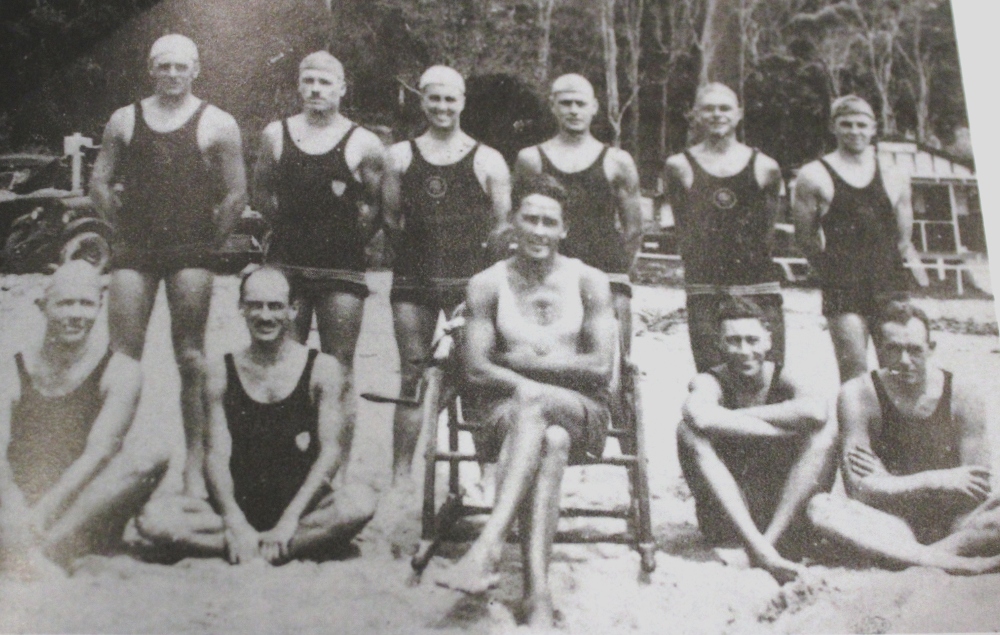
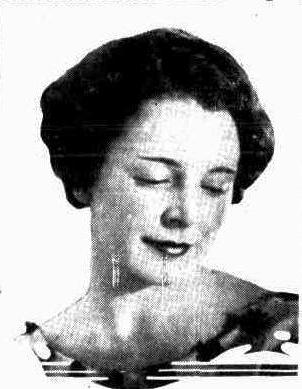
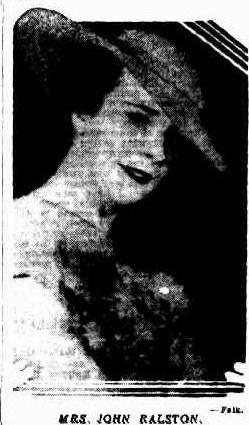
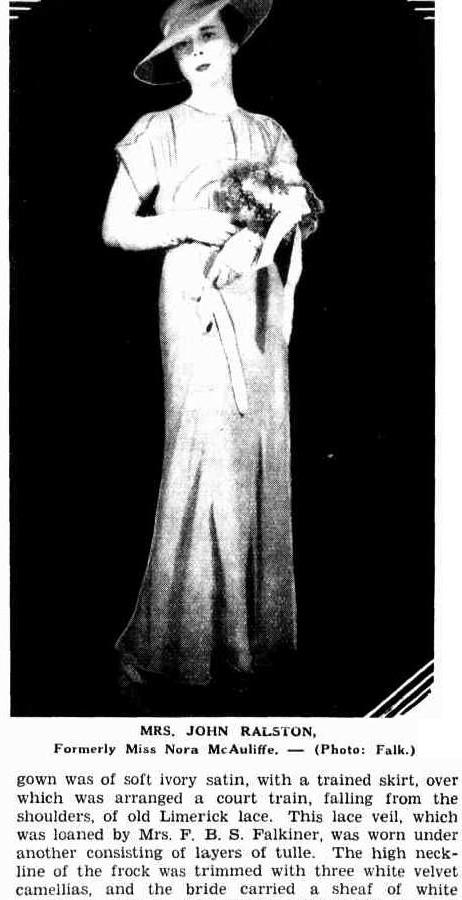
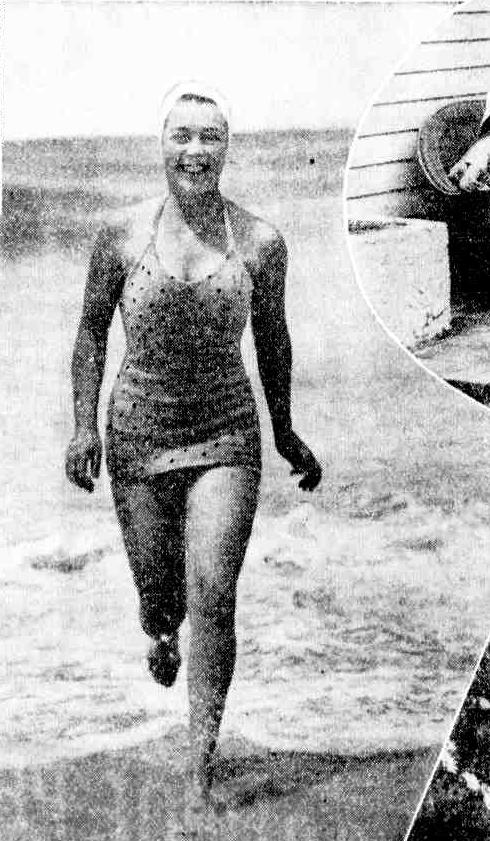
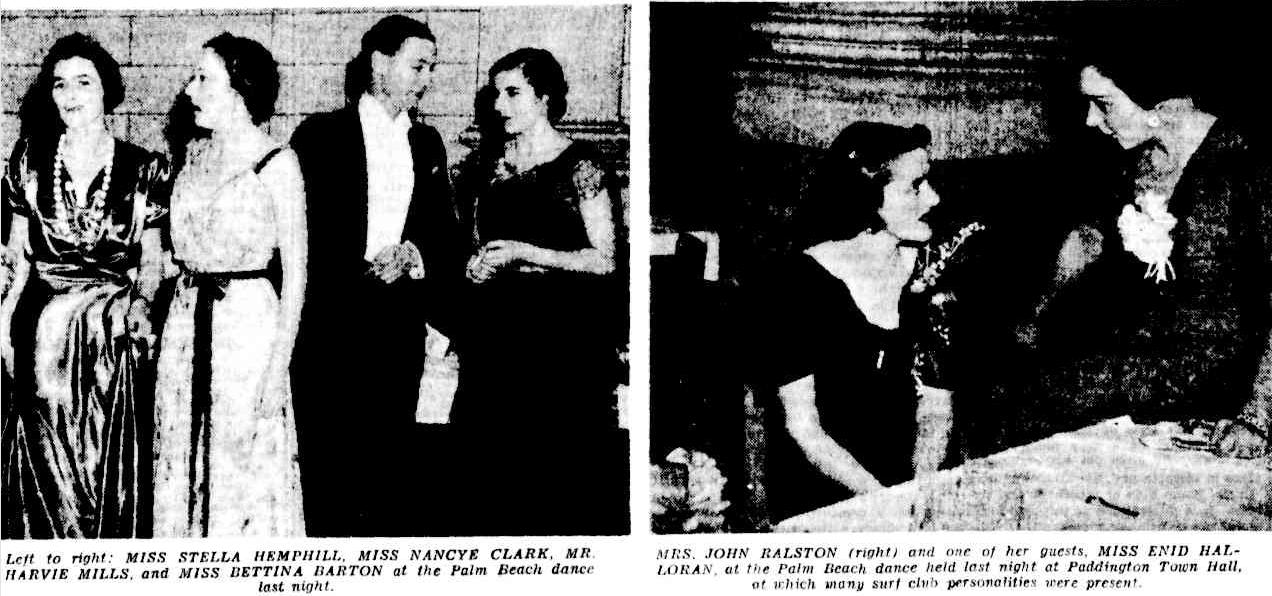
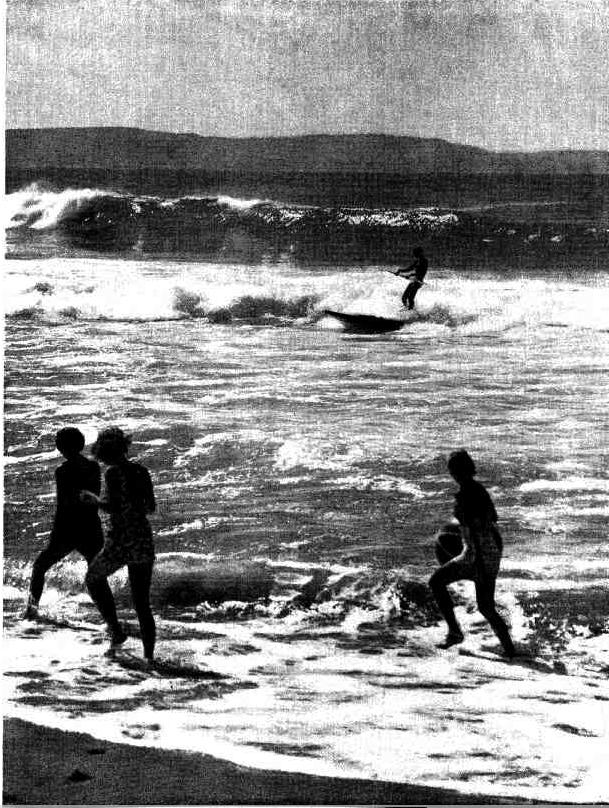
Women experts of the surf- board at Palm Beach.
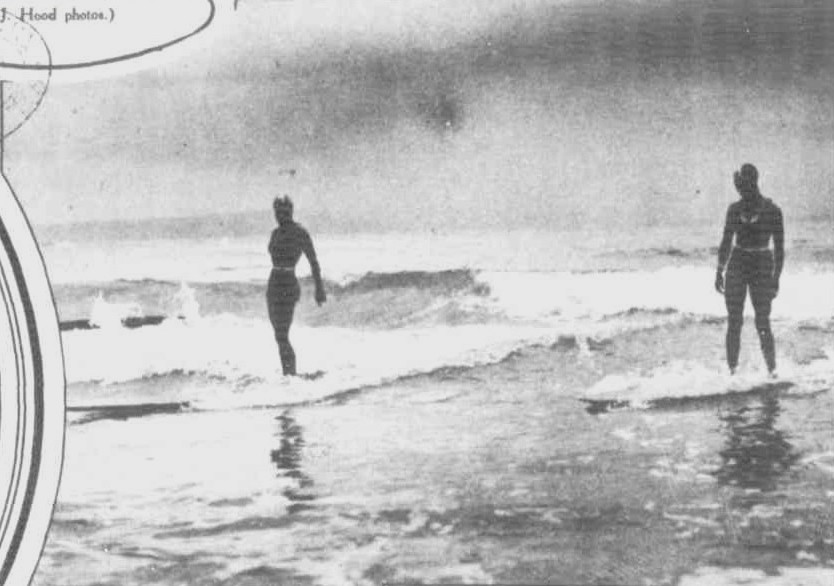
From Left.-Mrs. Alrema Samuels and Miss Norah Mc Auliffe. SYDNEY TOPICS – photos by S J Hood. (1930, January 11). The Australasian(Melbourne, Vic. : 1864 - 1946), p. 61 Edition: METROPOLITAN EDITION. Retrieved from http://nla.gov.au/nla.news-article141425116
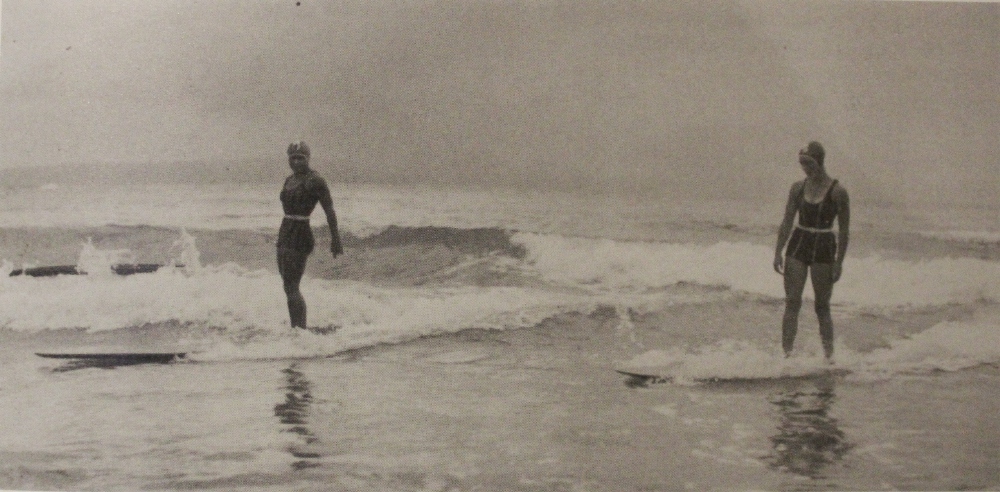
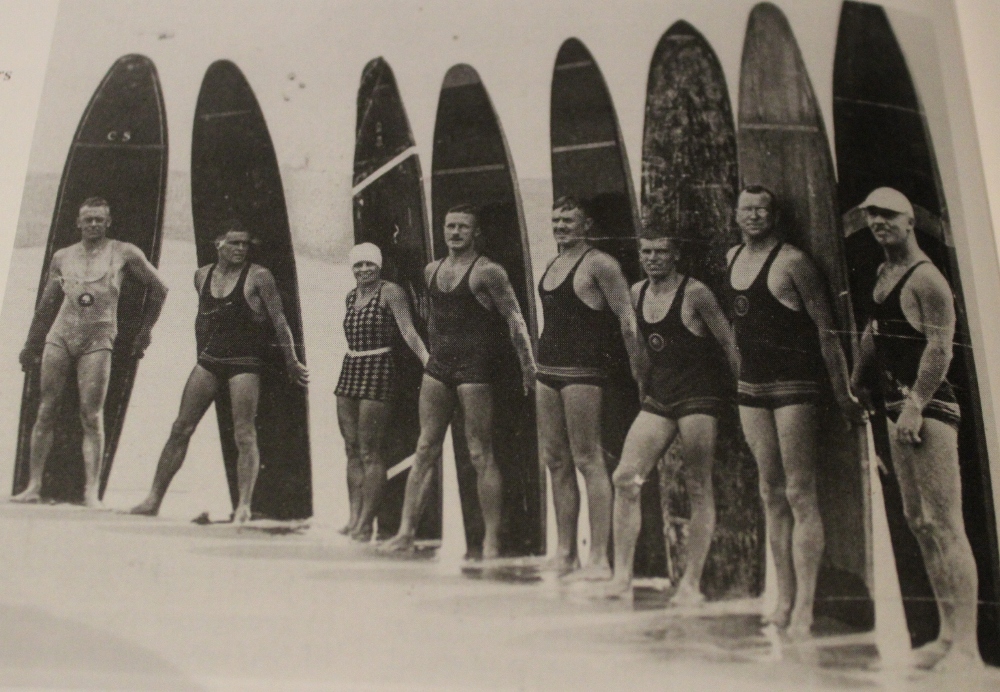
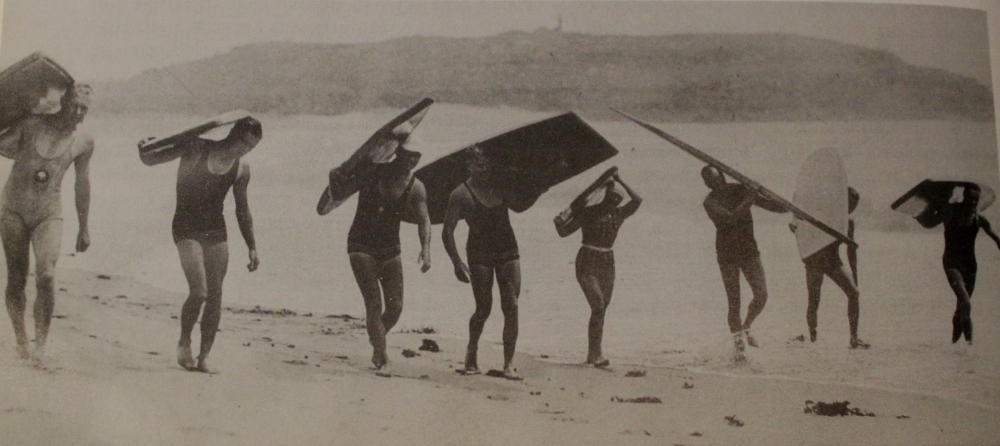
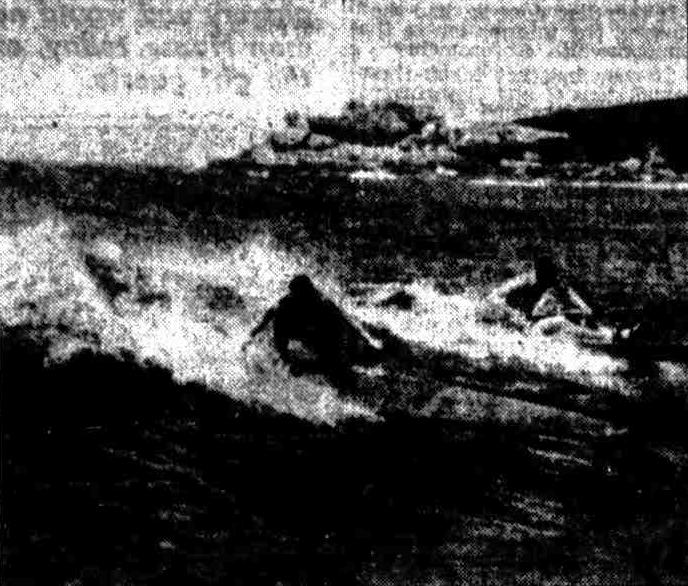
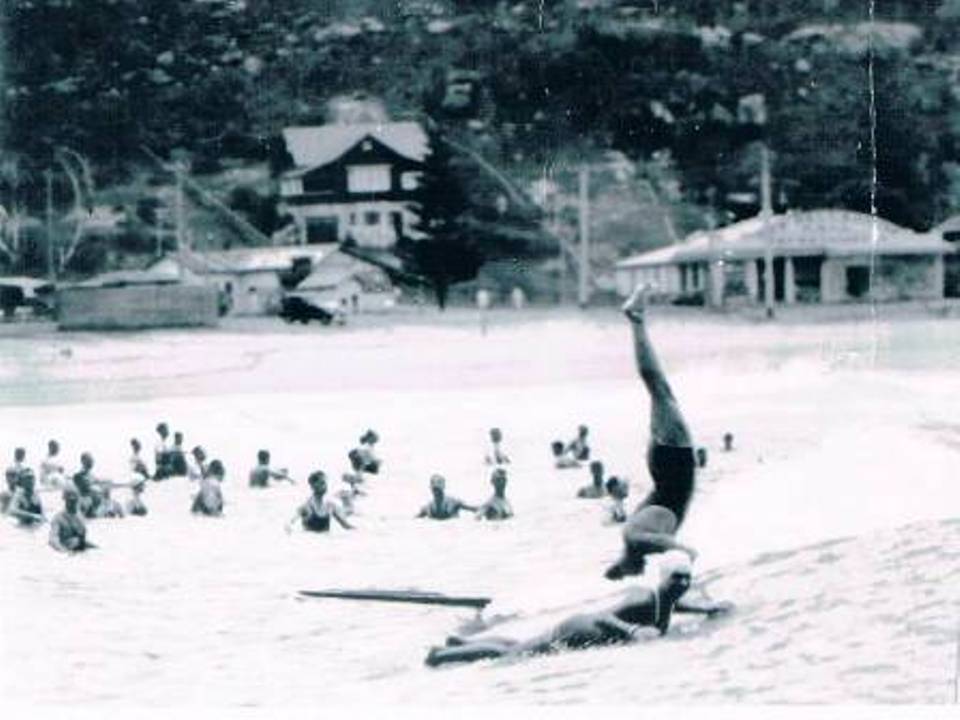
Adrian Curlewis, circa 1930
at Palm Beach - photo courtesy Philippa Poole - daughter of the 'Father of Surf Life Saving'
'During the 1930’s our family spent summer holidays at Palm Beach. This photo (above)of my father standing on his head followed him through life - particularly later in life when his career moved on to the role of a dignified District Court Judge.' - Philippa Poole, 2011
Judge Curlewis has grown up with the century. He is a "Federation baby" who has lived 50 eventful years
By HELEN FRIZELL, staff reporter
In January, 1901, most Australians were resolutely celebrating Federation. Ahead lay one hundred un-spoiled years, full of promise for on infant Commonwealth. But for Mr. and Mrs. Herbert Curlewis, of Mosman, N.S.W., January, 1901, meant not only the birth of a nation, but the birth of their son Adrian.
ADRIAN CURLEWIS has grown up with the century. He is one of those who have seen the horse replaced by cars and aeroplanes, the old fuel stove superseded by pressure cookers hissing over electricity or gas. Gone is the plentiful supply of domestic help in the home, and the days are vanished when no gentle-woman would wear lipstick.
The new century marked the end of an era and brought two world wars, the great depression, and the atomic age. In 1951, the Jubilee of Federation, Judge Adrian Curlewis, who has just celebrated his 50th birth-day, looks back at his life.
Today he is straight-backed and suntanned from his favorite relaxation-surfing. A caricaturist drawing his face would show a sharply defined nose, crinkly hair, and a high forehead.
In the evenings Judge Curlewis leaves the New South Wales District Court in the City of Sydney, picks up his car, and drives over the Harbor Bridge on his way home, thankful that the slow ferry to North Sydney has been replaced. Nearing home he calls in to say good-night to his mother, who is known to and loved by Australian children as the novelist Ethel Turner.
Tiny, white-haired Mrs. Curlewis, widow of Judge Herbert Curlewis, still lives in the rambling slate roofed house where her son grew up. Adrian Curlewis and his family live a mile away, in a modern cream house which overlooks the sparkling waters of Middle Harbor and the white sand of Chinaman's Beach.
District changes
MRS. ADRIAN CURLEWIS, 18 year-old Philippa, and 21-year old Ian have heard Judge Curlewis speak of the changes in the district where he grew up.In 1907, when he was six, Adrian Curlewis used to walk down to the beach (where he still swims before breakfast) among wildflowers and gumtrees. His parents' house was the only one standing. Now it is just one of many large homes perched on the hillside.
"I learnt to swim at Chinaman's Beach and the Spit Baths," says Judge Curlewis, now president of the Surf Life Saving Association of Australia. "My sister Jean, who died in 1930, and I used to dog-paddle from one end of the baths to the other."
Surfing was not then a popular sport, but devotees were conquering prejudice. The first Life Saving Clubs had just been formed.
Having an authoress for a mother did not seem a novelty to the young Curlewis'.
"I think we took the books for granted," says Adrian Curlewis. "I remember mother giving Jean and me 5/- each when she finished a book. It was a sort of celebration, and reward for good behaviour on our part."
In those days 5/- was wealth to a child. For a penny or ha'penny you could buy enough sweets to keep chewing for hours. Like other local boys, Adrian Curlewis enjoyed riding in the milk-man's cart, and meeting the electric tram which ran once an hour to the Spit.
Later on Adrian Curlewis went to the Mosman Preparatory School, then to Sydney Church of England Grammar School (Shore). At Shore young Adrian Curlewis went on to stroke the First Four, captain the Rugby Union Firsts, and to win the Headmaster's Cup for all-round sportsmanship.
He also became Senior Prefect in the middle of World War I.
"The war made a great impression on us all," says Judge Curlewis. "Every morning there was a chapel service for old boys killed in action. Many of these soldiers had been at school only a few years before, and we knew them well. As a prefect I took my turn at reading the lesson from the Bible, and felt moved at the solemn and very beautiful service taking place "
The thoughts that these services conjured up in the mind of the young Curlewis were later to take on harsh reality when, as a captain in the 8th Division, he was taken prisoner by the Japanese in Malaya.
Adrian Curlewis wanted to enlist in World War I, but his parents would not give their consent until he was 18. By then the war was nearly over, so he went to Sydney University to do Law.
During the strike of 1917, with hundreds of other schoolboys, he took an emergency job as an engine cleaner. He was forced to give it up when his father became Presiding Judge at the Arbitration Court. Curlewis the undergraduate was a young man with plenty of enthusiasm. His interests included playing the flute in the University orchestra, hockey, rowing, and swimming.
He revived the University Law Society and enjoyed himself riotously on Commem. Day. Up to 1921 the Sydney Town Hall had been the place where Blues were presented, where undergraduates shouted their faculty songs, where mothers and the girls of the moment came along to watch the celebrations.
"We were not allowed to use the Town Hall after '21," says the Judge Curlewis of to-day. "Something happened to the Town Hall organ, and the undergraduates footed the bill. Flour bombs were hurled down from the galleries, and hundreds of the cane chairs were broken.
"We weren't to blame for the chairs. The women did that when they stood on the chairs in their high heels."
In the 1921 procession law students of Adrian Curlewis' year satirised the Sydney Telephone Exchange. On top of a float a "telephone girl” (alias Curlewis) worked frenziedly at a switchboard, in company with the present Mr. Justice Mansfield, Mr. Justice Herron, and Judge Holt.
In January of the previous year Adrian Curlewis had decided to become a life-saver after seeing a drowning fatality while on holiday at Palm Beach, New South Wales. Palm Beach then was not the luxury resort it is today, but an informal bush settlement where a cluster of doctors' holiday homes marked Pill Hill.
Adrian Curlewis started the Palm Beach Life Saving Club with the late Len Palmer. Since then he has seen many changes in life-saving methods.
"The patient used to be carried from the water face up, and the limbs were rubbed to restore circulation," Judge Curlewis says.
(To-day life-savers carry patients face downwards, and the rubbing method is obsolete.)
"'With other old-timers, I prefer the original surfboats," says Judge Curlewis. "The Johnny Walker class surfboats were more solidly built, and were capable of tackling seas which would swamp the light, fast boats of to-day."
Adrian Curlewis learned surf-board riding from John Ralston, who had the first surfboard at Palm Beach. Later he bought his own surfboard for £5.
"It had belonged to Manly swimmer Claude West, who put an ad. in the paper reading: 'Surfboard for sale. Owner in hospital through using same'," Judge Curlewis told me.
(Surfboard riding was only six years old in 1920. The Hawaiian Duke Kahanamoku had introduced it to Australia in 1914.)
Surfboard virtuoso
AFTER mastering the surfboard and being able to ride it on either feet or head, Adrian Curlewis started teaching pretty Betty Carr, whom he had met at a Palm Beach house-party. Betty, who came from Kalgoorlie, Western Australia, learned surf-board riding quickly.
Before Adrian Curlewis was through Law they were engaged, and were married at St. Philip's, Church Hill, in December, 1928. Up to date with the fashions, the bride was photographed wearing a short wedding dress, with her hair caught up in a bandeau.
A week before Australia entered World War II, Adrian Curlewis enlisted. In January, 1941, he sailed for Malaya in the Queen Mary.
When Singapore fell the future Judge Curlewis, with thousands of other Australians, was captured and was sent to Changi. He was put to work on the wharves, and in April, 1943, was sent to the dreaded Thailand railway.
In the New Year, on January 26, 1946, Captain Curlewis was discharged from the Army. He is proud of the fact that he became a civilian at 4 o'clock and was in his chambers half an hour later with a brief for the next day. He was appointed a District Court Judge in 1948.
Judge Curlewis is a typical family man. Son Ian is now doing second year Law and is keenly interested in life-saving. Daughter Philippa has just left school after winning the All Schools' Senior Swimming Championship last year.
Judge Curlewis is a man of wide civic interests. They make quite a list:
He is president of the Surf Life Saving Association, chairman of the National Fitness Council of N.S.W., and chairman of the Red Cross Appeals Committee.
Keeping in touch with old school and Army friends, Judge Curlewis is on the Shore Council and the 8th Division Council.
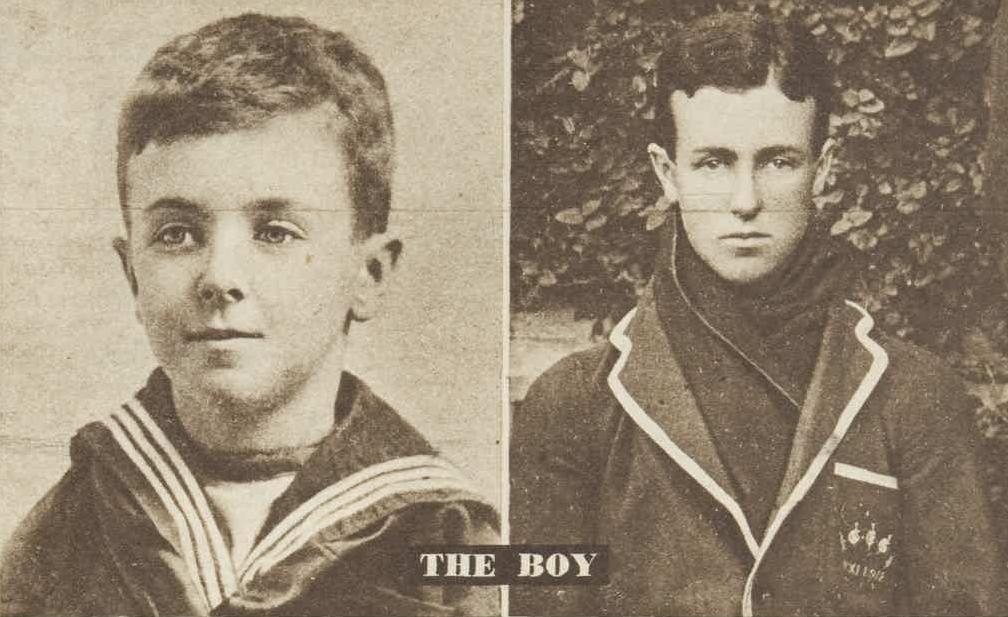
ADRIAN CURLEWIS at the age of nine. This picture was taken in London when Adrian was travelling with his family. In 1910 nearly all small boys were dressed in sailor suits by their mothers. THE BOY IN SCHOOL BLAZER, Adrian Curlewis posed for group picture of Shore's rowing four. The year was 1919, when boys wore serious expressions and long fringed scarves with their blazers.
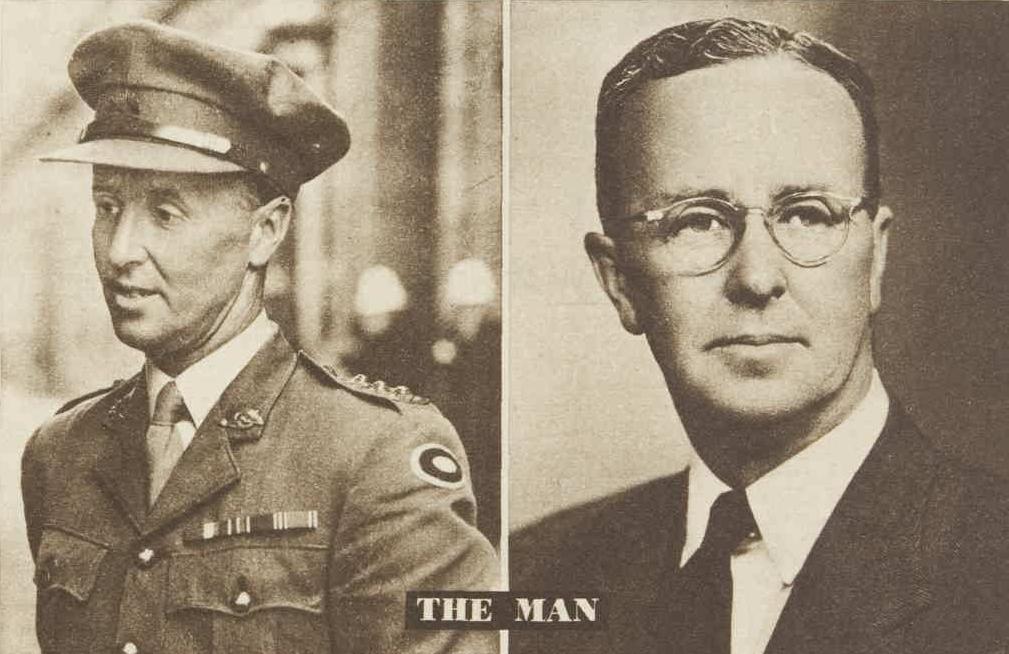
IN 1945 Captain Curlewis returned home alter three years in Changi and on the Thailand railway as a member of the 8th Division. TO-DAY, at the age of 50, Adrian Curlewis is a judge of the New South Wales District Court. He has a fine record of achievement.
Judge Curlewis has grown up with the century (1951, February 3). The Australian Women's Weekly (1933 - 1982), p. 17. Retrieved fromhttp://nla.gov.au/nla.news-article51595911
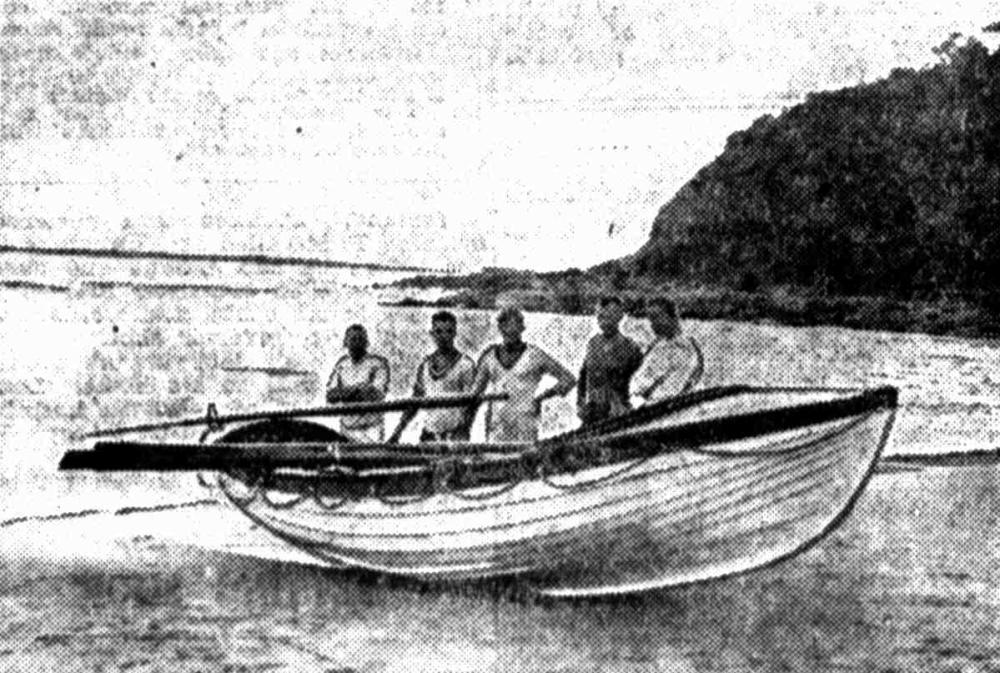
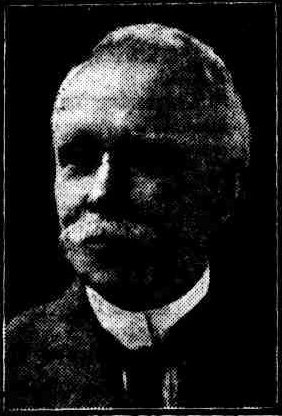 The death occurred at his residence, Gulaston, Ranger's Road, Neutral Bay, at about 8 o'clock last night, of Mr. John Thompson Ralston, the well-known Sydney solicitor. Mr. Ralston, who was a son of the late Mr. Alexander James Ralston, the first secretary of the Australian Mutual Provident Society, was admitted as a solicitor in the early Nineties, and had practised his profession in Pitt-street continuously since then.
The death occurred at his residence, Gulaston, Ranger's Road, Neutral Bay, at about 8 o'clock last night, of Mr. John Thompson Ralston, the well-known Sydney solicitor. Mr. Ralston, who was a son of the late Mr. Alexander James Ralston, the first secretary of the Australian Mutual Provident Society, was admitted as a solicitor in the early Nineties, and had practised his profession in Pitt-street continuously since then.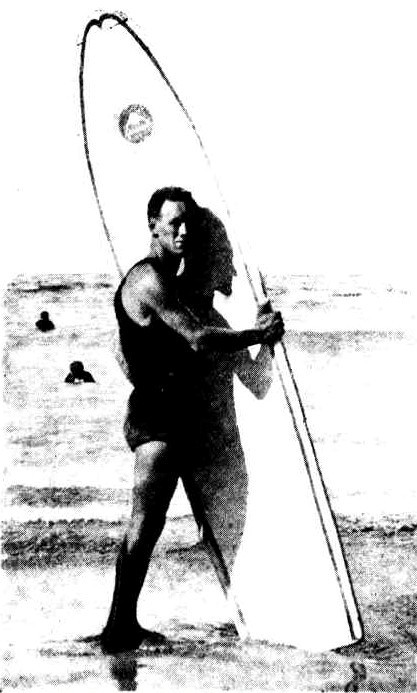
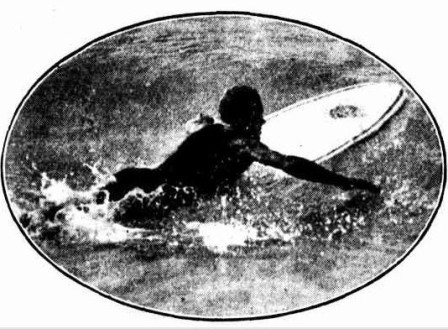
THE SURF BOARD FOR LIFE-SAVING. Claude West, a life-saver stationed at Manly, is an expert in the use of the surf board, which is sometimes used to go out to a bather in distress. The picture on the left (below)shows the swimmer going out; in the other he is coming in with a 'rescue.'
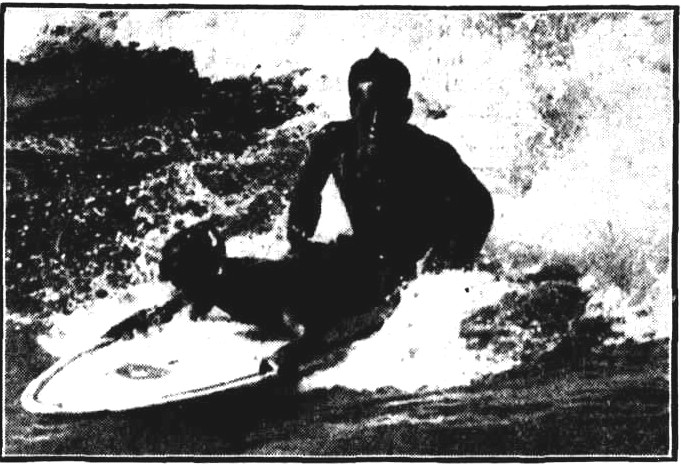
Life-Savers of the Surf. (1925, February 25). Sydney Mail (NSW : 1912 - 1938), p. 8. Retrieved from http://nla.gov.au/nla.news-article159720700
Claude West (1898 - 1980), was apparently taught to surf by Duke Kahanamoku. He may have seen some of the 'surf board shoots' that took place as part of the January 26th Freshwater carnival of 1912, on a board brought back to Australia by Manly's C D Paterson in 1911, or seen the article which appeared later that year in the Sydney Mail or known Tommy Walker - see below.
HEALY'S CONQUEROR. DUKE KAHANAMOKU, THE HAWAIIAN. COMES OF SEMI-AMPHIBIAN ANCESTORS SOME LONG DISTANCE SWIMS
Duke Kahanamoku the winner of the 100 metres race at the Olympic Games and the conquerer of Cecil Healy, Sydney's well-known topnotcher, is one of fastest short-distance swimmers in the world. At the back of the Hawaiian is a long of semi-amphibious humans. From the day he is born till the hour he dies the Hawaiian is never wholly out of sound of the soft lap-lap of the waves on the reefs sur rounding his native islands.The sea is his mother, father, and playmate— hardly ever his enemy. From the time he can walk, and sometimes before he begins to dabble in the ocean, and no enchantment held forth by later sports can wean him away from its lure. Duke Kahanamouku cannot begin to touch, in these games, the long-distance records made by some of his countrymen and countrywomen. Here is a typical Instance says the 'Times's Democrat' of May 26) ... HEALY'S CONQUEROR. (1912, July 13). Evening News (Sydney, NSW : 1869 - 1931), p. 5. Retrieved from http://nla.gov.au/nla.news-article114477764
RIDING THE SURF AT HONOLULU.
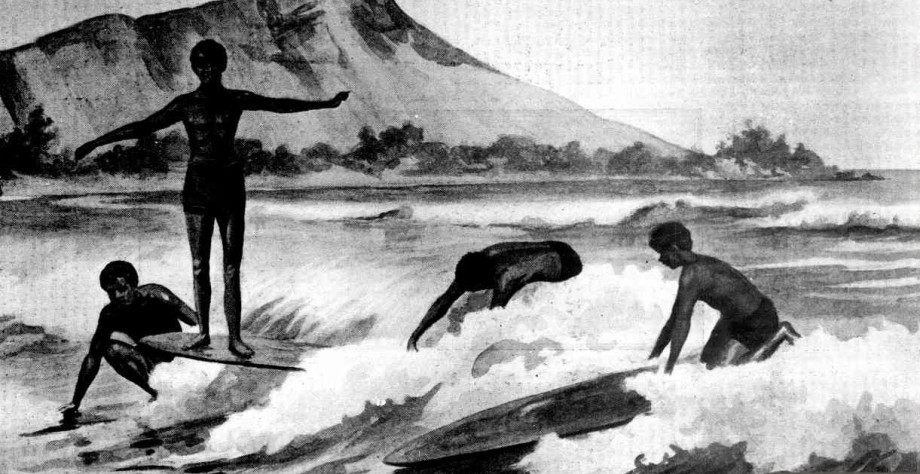
drawn by Agnes Gardner-King — Copyright.
EVERYONE has heard of the surfrriders of Honolulu. Sydney got the idea from the South Sea Islands, but Australians, except on rare occasions, dispense with the board, and 'ride' the waves without artificial aid. Miss Agnes Gardner-King, in contributing the above drawing, writes: — 'The natives take a long pointed board and, after giving it the necessary forward motion to start it on its journey on the crest of the wave, are able to enjoy a delicious ride sitting or even standing on their frail support, till the wave either loses itself or breaks on the beach. The exquisite colouring of the blue water contrasting with the rich brown skins of the natives make the scene a lovely one. Note the proud native turning sideways to receive the plaudits of our little group on the beach.' RIDING THE SURF AT HONOLULU. (1912, December 25).Sydney Mail (NSW : 1912 - 1938), p. 30. Retrieved fromhttp://nla.gov.au/nla.news-article158479458
Two Ways of surfing.
Mr. J. Donnelly (North Sydney) writes:— . In your Issue of January 14 Mr. L. A. Brodd tells us that there are two ways of surfing — American and Australian, and clearly shows, us once more that there is only one way of boosting— American. In asking Australians to imagine 20,000 people bathing on a beach a mile and a half long sets us a severe task. I for one essayed the task, and was completely prostrated to think that there was one person bathing In every square yard for forty-five yards out along one and a half mile of beach, leaving 1200 rash bathers over to go out of sight of land, get drowned, and other silly things. I can quite understand how Australians excel at shooting the breakers. What a lovely building the dressing-shed, house, mansion or palace must be to accommodate 120.000 people, each having a nice room all to himself; and just fancy 120,000 people paying 2b each, totalling the trifling sum of £12.000, for the pleasure of bobbing up and down in a square yard of water. Is Mr. L. A. Brodd trying to Americanise Australians by asking them to "imagine"? I hope you will publish this in, Justice to our life-savers, whom Mr. L. A. Brodd seems to think are a long way behind the Americans, yet in the same breath he says more lives are lost in the Land of Boost. He covers, this with an explanation— viz., when a man calls for help he is so far away that they cannot reach him in time. What powerful voices the Americans must have, or do all bathers carry a megaphone?TWO WAYS OF SURFING. (1913, January 17). The Sun (Sydney, NSW : 1910 - 1954), p. 12 (FINAL EXTRA). Retrieved fromhttp://nla.gov.au/nla.news-article228713833
DANGEROUS SURFING BOARDS.
The thousands of visitors who flock to the beaches near Sydney to view the surf bathing are often amazed (says the Sydney 'Daily Telegraph') at the remarkable feats performed by bathers, who shoot the breakers with surf boards. Many expert 'board-shooters' can rise on the crest of breaker a quarter of a mile out and travel to the beach with torpedo velocity. The sport is exhilarating and fascinating, but the practice is roundly condemned by surf bathers who shun the board-shooter as they would a shark. Several accidents have happened in the breakers through a board striking bathers whilst the user of it was performing some daring exploit through the crowd of bathers. So dangerous has the practice become at Manly that the Council's beach inspector reported to the aldermen at their last meeting that some action should be taken in the matter. He suggested that the Council set apart a portion of South Steyne for board-shooters alone, as it was impossible to check the nuisance. The aldermen did not adopt this view of the question. They discussed the matter warmly, arid made it plain that the Council had the necessary power to prosecute offenders. Regulations it had been passed giving the officials power' to warn bathers who indiscriminately used these boards to the danger of other bathers. and to prosecute if necessary. In future a close eye will be kept on bathers who enter the water at Manly armed with the surf board, and if they decline to dispense with the board the offenders are to be prosecuted. DANGEROUS SURFING BOARDS. (1913, February 6). Daily Telegraph (Launceston, Tas. : 1883 - 1928), p. 4. Retrieved fromhttp://nla.gov.au/nla.news-article152886932
DUKE KAHANAMOUKU

The marvellous Hawaiian, undisputed champion sprint distance swimmer of the world, some of whose natatorial feats are said to have astounded the fishes, as did the exploits of Pegoud, the French aviator, in the clouds, cause wonderment amongst the birds of the air. He is here seen performing one of his famous surfing accomplishments. This is not by any means his most daring achievement. Whilst dashing forward at an incredible speed, he stands on his head and does other things of an acrobatic description. Similar boards to the one he is shown using have been imported into Australia, but so far none of our surfing experts have been able to imitate his sensational deeds.
It is supposed, however, that the breakers that roll in on our shores are of a different formation, and not suitable for the purpose. All doubts on that subject would have been set at rest had Kahanamouku visited here this Summer, as was supposed to have been his intention. He has on several occasions expressed his willingness to come, but the time he originally offered to make the trip was regarded as inopportune by the officials of the Swimming Association who were carrying on the negotiations, and they fell through, owing to the date they suggested as a substitute clashing with the great water festival that is to be held at Honolulu on February 18 and 24 next. Visitors from all parts of the world have been known to go to Hawaii merely to witness Kahanamouku shoot the waves in the extraordinary fashion depicted above. DUKE KAHANAMOUKU (1913, December 14). Sunday Times (Sydney, NSW : 1895 - 1930), p. 20 (SUNDAY TIMES GLOBE PICTORIAL). Retrieved from http://nla.gov.au/nla.news-article126315151
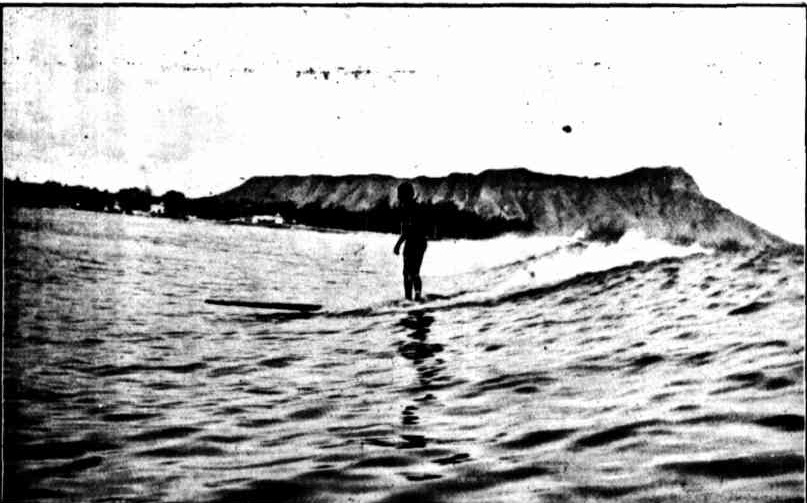
SURF BOARD RIDING, WAIKIKI BEACH, HONOLULU.
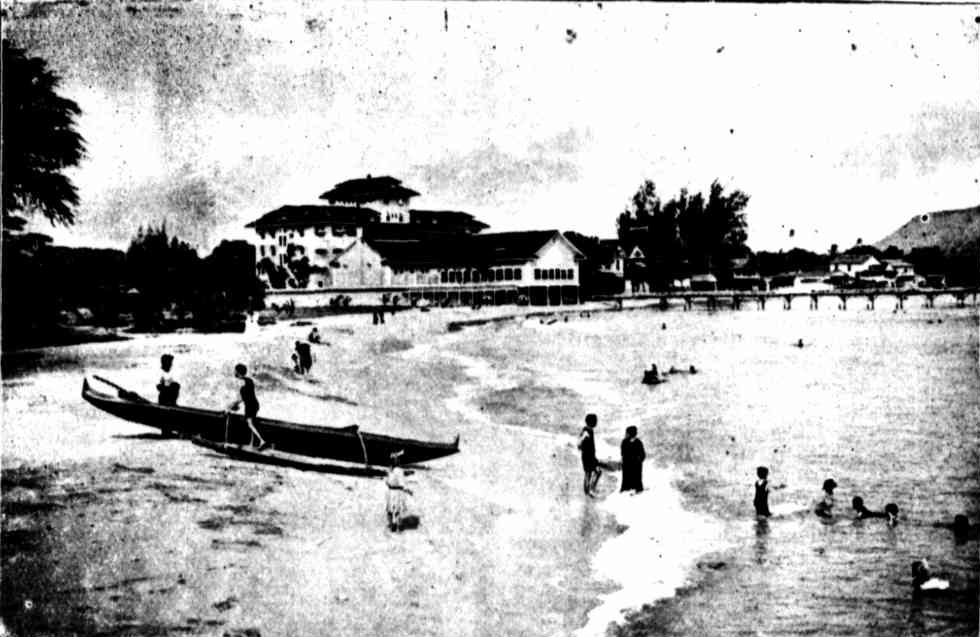
WAIKIKI BEACH AND MOANA HOTEL, HONOLULU.
No Title (1913, June 3). Kalgoorlie Western Argus (WA : 1896 - 1916), p. 21. Retrieved from http://nla.gov.au/nla.news-article33423081
Tommy Walker Says— 'I Brought First Surfboard To Australia'
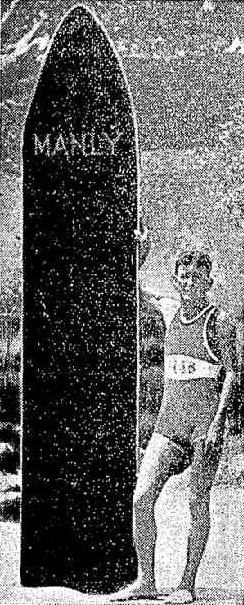 IN a letter to Harry M. Hay, Australia’s foremost swimming and, surf coach, Tommy Walker, one-time surfboard champion at Manly (N.S.W.), writes: 'I saw an article by you in 'The Referee' re surfboards. so enclose a photo of myself and surfboard taken in 1909 at Manly. This board I bought at Waikiki Beach, Hawaii, for two dollars, when I called there aboard the 'Poltolock.' I won my first surfboard shooting competition at Freshwater carnival back in 1911,and that wasn't yesterday. Regards.'
IN a letter to Harry M. Hay, Australia’s foremost swimming and, surf coach, Tommy Walker, one-time surfboard champion at Manly (N.S.W.), writes: 'I saw an article by you in 'The Referee' re surfboards. so enclose a photo of myself and surfboard taken in 1909 at Manly. This board I bought at Waikiki Beach, Hawaii, for two dollars, when I called there aboard the 'Poltolock.' I won my first surfboard shooting competition at Freshwater carnival back in 1911,and that wasn't yesterday. Regards.'
Walker was a well-known figure at Manly at the time he writes about. He figured in a couple of unusual, if not remarkable, incidents.
Time came when Tommy decided to catch a shark for the purpose of exhibiting it to the public at threepence a head. He brought three other lads into the enterprise and between them they raised the necessary capital to buy a hook and line and to hire a tent in which to install the monster of the deep. But first they 'had 'to catch their fish. They selected Fairy. Bower beach as their base and set a watch on the hill overlooking it. On the second day of their vigil, the required shark was sighted. Like a policeman on his beat, he came leisurely from the direction of South Steyne. And he was a Whopper, a tiger, 14ft 2in in length, as was proved later. He was duly landed struggling on the beach and a curious public had paid £12/10/to view him when the Council's inspector of nuisances intervened to the manifest relief of the residents in the vicinity. But one may ask, 'Where' does the hero stuff come in?' Well, it was this way. When the shark was sighted, the watchers on the. Hill signalled to Tommy (who was waiting on the' beach) and he immediately set out in a small dinghy to drop the bait at the spot it was anticipated the shark would cross. The craft capsized. So Tommy swam with the bait, a -7lb salmon, and literally spilt it into the shark's mouth. The shark grabbed it— and the rest was easy. Someone said, 'I ..wouldn't have done that for £10,000.' ..Tommy replied simply, .''There was no danger — when salmon are about, a shark has no time for anything else.'
IN the other incident Ivay Schilling was the heroine. She Will be recalled as J. C. Williamson's principal dancer. The company was having a successful season at the Theatre Royal. A strong swimmer, she was surfing at South Steyne one morning, when only two others were in the water. Walker was one of them. Miss Schilling had crossed a deep channel and was resting on a sandbank, and was watching Walker shooting. He could swim like a fish. This was at a time when large surfboards were unknown in Australian waters. However, Walker did not need any adventitious aids when shooting, at which he was one of the recognised adepts. It was impracticable, however, to shoot right into the sand because of the channel, which banked the surf up. After his third shoot, Walker appeared to be in sore trouble in the channel. His scream for help galvanised the dancing star into action. -With powerful strokes, swimming trudgeon style, she quickly covered the necessary 30 yards to reach the youth who was sinking for the third time. He appeared to 'be- in a fit- and struggled violently as the gallant lady swam with him to' the shore.
JUST at this moment the professional lifesaver, the late 'Appy Eyre, arrived and he worked on the unconscious form of Walker, who, when he came to his senses, ejaculated, ''Well, that is the last time I'll go surfing immediately after' a heavy' breakfast.' ?
TOMMY WALKER
The evening papers rang with the story, and the performance at the Royal was held up that night when Miss Schilling appeared on the stage. Members of the audience from all parts of the theatre rose and cheered, and cheered, and cheered again. And Tommy — what of him? Just about that time, a week beforehand, in fact, Claude Eric Ferguson McKay had been appointed to the position as Williamson's publicity man. 'Walker, if unwittingly, had brought one of Williamson's stars into the limelight— had given her the opportunity of appearing as a heroine in a drama off the stage. McKay was delighted. He presented Walker with a brand new £5 note. Tommy Walker Says—. (1939, February 23). Referee (Sydney, NSW : 1886 - 1939), p. 16. Retrieved from http://nla.gov.au/nla.news-article127604199
DEE WHY CARNIVAL. KAHANAMOKU AND HIS SURF BOARD.
D. P. Kahanamoku, the famous Hawaiian swimmer, gave an exhibition on the surf board at the Dee Why surf carnival on Saturday. The beach was lined with people, all anxious to obtain a good view. The various events were watched with interest, especially the performance of Kahanamoku. He came out with his surf board, plunged into the water and continued to swim out until those watching from the beach wondered when he would stop. After covering nearly half a mile, Kahanamoku turned and prepared for a roller, which came along a moment after ; he caught it, and as the wave carried him shorewards he performed all kinds of acrobatic feats on the board, and finally dived into the water as the roller broke. The crowd showed their appreciation in a very hearty manner. Kahanamoku remained in the surf for nearly an hour, and he was accompanied at intervals by Miss Letham, of Freshwater, and it was a rare sight to watch both swimmers on the surf board.
The various surf events under the control of the New South Wales Surf Bathing Association were well contested. An open-air concert at night concluded the day's sport. Details :—
Grand Parade of Clubs.—Dee Why, 1 ; North Steyne, 2.
Three-legged Race.—North Steyne, 1 ; Collaroy, 2.
Pennant Rescue and Resuscitation Competition.— Metropolitan Division, third round ; Bondi A, 57.77points, 1 ; Manly A, 57.47 points, 2 ; Coogee, 56.66points, 3 ; North Steyne, 52.03 points, 4.
Novice Surf Race.—A. V. Rein (Manly), 1 ; C. D. Bell (Manly), 2.
Tug-of-War.—Collaroy, A. L. Melrose, capt. ; C. Knight, J. Walton, A. Thew, J. Jack, J. Bloomfield, D. Scully), 1.
Beach Relay Race.—First heat : Collaroy, 1. Second heat : North Steyne, 1. Third heat : Coogee, 1. Final :Collaroy (L. Chinchen, T. V. Smith, A. Sheldon, L. Sheldon), 1 ; North Steyne (E. Goulding, G. Morgan,O. H. G. Merrett, C .Whitehead), 2.
Alarm Reel Race.—Manly (H. M. May, belt, O. Mater, H. Buhl, F. Bennett, D. West), 1 ; NorthSteyne (L. Hind, belt, F. Nicholls, B. McEwan, E. Goulding, N. Thompson), 2.
Cock Fight.—Balmoral ( J. Doudney, C. Walker), 1.Surf Brace Relay Race.—Manly (J. Brown and N. Smith), 1 ; North Steyne (C. Healy, L Solomon), andBondi (J. G. Brown and H. Fletcher), dead heat.
Novice Alarm Reel Race.—First heat : North Steyne,1 ; North Bondi, 2. Second heat : Coogee, 1. Thirdheat : Bondi, 1. Final : Coogee (J. Leary, H. Mason,H. McClure, R. Harret, M. Reubenstein), 1.
Wheelbarrow Race.—North Steyne (H. Nicholls, F. E. Nicholls), 1. DEE WHY CARNIVAL. (1915, February 8). The Sydney Morning Herald (NSW : 1842 - 1954), p. 13. Retrieved from http://nla.gov.au/nla.news-article15549791
SURF BOARDS PROHIBITED. At the last Meeting of the Waverley Council an application was received from Mr. F. Foran for permission to use a surf board at Bondi. It was decided to Inform the applicant that the practice of surf shooting by means of a surf board was one that should not be encouraged, as It caused Inconvenience and annoyance to the public. The Inspectors were ordered to see that The practice was discontinued.SURF BOARDS PROHIBITED. (1916, April 19). Evening News(Sydney, NSW : 1869 - 1931), p. 6. Retrieved from http://nla.gov.au/nla.news-article115838277
Why are surfboards registered? EVEN though the 5/- registration fee is such a small amount, I still think it fair that we should know for what reason we register our boards. The "boys from the club" had come round the beach to collect fees, and a conversation along these lines followed:
Us: Why do we have to register boards?
Them: You have to register cars for the use of the road, so you register boards for the use of the beach.
Us: But there is a lot of upkeep as far as the use of roads is concerned. What upkeep, apart from cleaning up, is there on the beaches?
Them: You have to have a beach patrol.
Us: Lifesavers patrol the body-surfing area, not the board area. Boardriders if in trouble rely on other riders. Why not make body-surfers pay a registration fee?
Them: If you hit a bodysurfer and your board isn't registered and a lot of damage is caused you can be sued for everything. Whereas, if your board is registered, you have a fair chance of getting off more lightly.
Us: How ridiculous! Whether or not your board is registered isn't going to make any difference in how much they sue you for. Any-way, it's your job to keep body-surfers out of the board area. We manage to keep out of the body area.
We weren't kicking up a fuss about paying the 5/-,we just want to know why. We never did find out. - "Bilgola Bunny," Beecroft, N.S.W. Letters.(1965, December 29). The Australian Women's Weekly (1933 - 1982), p. 48. Retrieved from http://nla.gov.au/nla.news-article51190827
MANLY MEN OUT.
On Wednesday at 2 o'clock the men employed in the Manly gasworks threw down their tools, and went out. The strikers number 40. Only the manager and foreman remained at their posts. Volunteers were at once available as soon as the manager, Mr. McAuliffe, sent them word. In fact, there was a surplus. So there was no stoppage, and stoking is now proceeding without inconvenience. It is not anticipated that there will be any real difficulties. The three holders being full, there is a three-days' supply in reserve with a reduced pressure. There is also plenty of coal on hand sufficient to keep the retorts fed for several weeks. The manager was greatly surprised when told that the men had knocked off. The spokesman gave as a reason that the coal-lumper engaged unloading the Yullo of coal had stated that they would not have turned to if they had known the gas employees were at work. When the manager inquired of the lumpers, they indignantly denied the statement attributed to them, and added that their union had told them there was no reason why they should black-list the Manly works, as it was understood that the employees were satisfied. The manager said that these strikers were all paid union wages, and had made no complaint . "An impression is abroad," he remarked, "that they are not well paid. No stoker gets less than 10/ per day, with time and a half for Sundays, making the minimum wage £3/15 while some earn £4/0/4. The lowest rate paid to any employee is 8/ per day, although it has been reported that this was the highest wage paid to stokers. Men laying pipes in soft soil received 8/ per day, and rockchoppers 10/4 per day." Directly the men decided to strike they left the works without any ado. So far there has not been any attempt to picket the place and the only evidence of anything unusual happening on Wednesday night was the appearance of a police officer at the gate. MANLY MEN OUT. (1913, March 6). The Maitland Daily Mercury (NSW : 1894 - 1939), p. 5. Retrieved from http://nla.gov.au/nla.news-article121288437
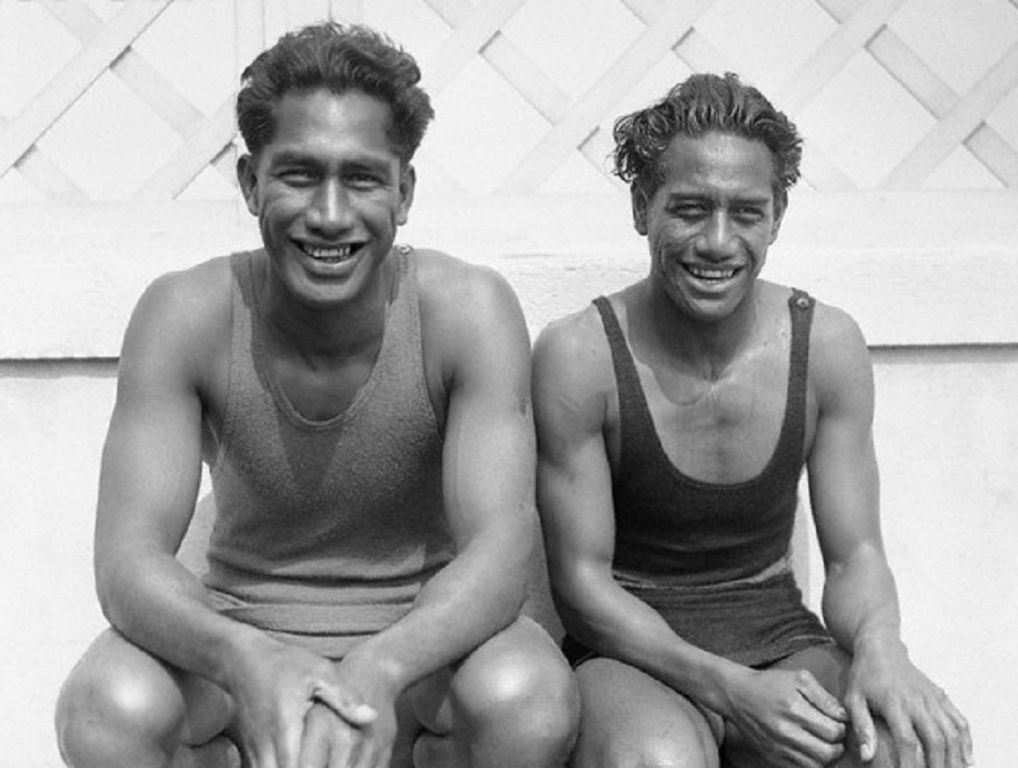
Previous History Pages:
Marie Byles Lucy Gullett Kookoomgiligai Frank Hurley Archpriest JJ Therry Sir Patrick Gordon Taylor Bowen Bungaree W. Bradley 1788 Journal Midholme Loggan Rock Cabin La Corniche La Corniche II Lion Island Bungan Beach Botham Beach Scarred Trees Castles in the Sand Dame Nellie Melba lunches at Bilgola Spring, 1914 First to Fly in Australia at North Narrabeen Mona Vale Golf Club's Annual Balls Governor Phillip camps on Resolute Beach Ruth Bedford Jean Curlewis Mollie Horseman Charlotte Boutin May Moore Neville W Cayley Leon Houreux Frederick Wymark Sir Adrian Curlewis Bilgola Heron Cove Mullet Creek Shark Point Woodley's Cottage A Tent at The Basin Collin's Retreat-Bay View House-Scott's Hotel Bilgola Cottage and House The First Pittwater Regatta Women Cricketers Picnic Filmed In Pittwater Governor Phillip's Barrenjoey Cairn Waradiel Season The Church at Church Point Gov. Phillip's Exploration of Broken Bay, 2 - 9 March 1788 Petroglyths: Aboriginal Rock Art on the Northern Beaches Avalon Headland Landmarks Steamers Part I Pittwater Aquatic Club Part I Woody Point Yacht Club Royal Motor Yacht Club Part I Dorothea Mackellar Elaine Haxton Neva Carr Glynn Margaret Mulvey Jean Mary Daly Walter Oswald Watt Wilfrid Kingsford Smith John William Cherry George Scotty Allan McCarrs Creek Narrabeen Creek Careel Creek Currawong Beach Creek Bushrangers at Pittwater Smuggling at Broken Bay An Illicit Still at McCarr's Creek The Murder of David Foley Mona Vale Outrages Avalon Camping Ground Bayview Koala Sanctuary Ingleside Powder Works Palm Beach Golf Course Avalon Sailing Club Mona Vale Surf Life Saving Club Palm Beach SLSC Part I - The Sheds Warriewood SLSC Whale Beach SLSC Flagstaff Hill Mount Loftus Pill Hill Sheep Station Hill S.S. Florrie S.S. Phoenix and General Gordon Paddlewheeler MV Reliance The Elvina Florida House Careel House Ocean House and Billabong Melrose-The Green Frog The Small Yacht Cruising Club of Pittwater Canoe and I Go With The Mosquito Fleet - 1896 Pittwater Regattas Part I - Dates and Flagships to 1950 Shark Incidents In Pittwater The Kalori Church Point Wharf Bayview Wharf Newport Wharf Palm Beach Jetty - Gow's Wharf Max Watt Sir Francis Anderson Mark Foy John Roche Albert Verrills Broken Bay Customs Station At Barrenjoey Broken Bay Water Police Broken Bay Marine Rescue - Volunteer Coastal Patrol Pittwater Fire-Boats Prospector Powder Hulk at Towler's Bay Naval Visits to Pittwater 1788-1952 Pittwater's Torpedo Wharf and Range Naval Sea Cadets in Pittwater S.S. Charlotte Fenwick S.S. Erringhi P.S. Namoi S.Y. Ena I, II and III Barrenjoey Headland - The Lessees Barrenjoey Lighthouse - The Construction Barrenjoey Broken Bay Shipwrecks Up To 1900 Barrenjoey Light Keepers Douglas Adrian Ross Newport SLSC 1909 - 1938 Part I Overview North Narrabeen SLSC - The Formative Years Bilgola SLSC - the First 10 years North Palm Beach SLSC A History of Pittwater Parts 1 and 4 Pittwater Regattas - 1907 and 1908 Pittwater Regattas - 1921 - The Year that Opened and Closed with a Regatta on Pittwater Pittwater Regatta Banishes Depression - 1933 The 1937 Pittwater Regatta - A Fashionable Affair Careel Bay Jetty-Wharf-Boatshed Gow-Gonsalves Boatshed -Snapperman Beach Camping at Narrabeen - A Trickle then a Flood Pittwater's Parallel Estuary - The Cowan 'Creek' RMYC Broken Bay Boathouse and Boatshed Barrenjoey Boat House The Bona - Classic Wooden Racing Yacht Mona Vale Hospital Golden Jubilee - A Few Insights on 50 Years as a Community Hospital Far West Children's Health Scheme - the Formation Years The First Scotland Island Cup, Trophy and Race and the Gentleman who loved Elvina Bay Royal Motor Yacht Club Broken Bay NSW - Cruiser Division History - A History of the oldest division in the Royal Motor Yacht Club Royal Motor Yacht Club Broken Bay Early Motor Boats and Yachts, their Builders and Ocean Races to Broken Bay, the Hawkesbury and Pittwater The Royal Easter Show Began As the Royal Agricultural Society of New South Wales The Mail Route to Pittwater and Beyond The Wild Coachmen of Pittwater - A Long and Sometimes Bumpy Ride on Tracks Instead of Roads The Fearless Men of Palm Beach SLSC's Surf Boats First Crews - A Tale of Viking Ships, Butcher Boats and Robert Gow's Tom Thumb 'Canoe' Furlough House Narrabeen - Restful Sea Breezes For Children and Their Mothers From Telegraphs to Telephones - For All Ships at Sea and Those On Land Mona Vale Training Grounds - From Lancers on Horses to Lasses on Transport Courses Fred Verrills; Builder of Bridges and Roads within Australia during WWII, Builder of Palm Beach Afterwards Communications with Pittwater Ferries To Pittwater A History of Pittwater - Part 4: West Head Fortress Pittwater's Lone Rangers - 120 Years of Ku-Ring-Gai Chase and the Men of Flowers Inspired by Eccleston Du Faur Early Pittwater Launches and Ferries Runs Avalon Beach SLSC - The First Clubhouse Avalon Beach SLSC The Second and Third Clubhouses From Beneath the Floorboards at Hyde Park Barracks Bungaree Was Flamboyant Andrew Thompson - 'Long Harry' Albert Thomas Black John Collins of Avalon Narrabeen Prawning Times - A Seasonal Tide of Returnings Oystering in the Pittwater Estuary - Oyster Kings and Pearl Kings and When Not to Harvest Oysters Yabbying In Warriewood Creeks Eeling in Warriewood's Creeks (Includes A Short History of community involvement in environmental issues/campaigns in and around Narrabeen Lagoon - 1974 to present by David James OAM) Eunice Minnie Stelzer - Pittwater Matriarchs Maria Louisa Therry - Pittwater Matriarch Katherine Mary Roche - Pittwater Matriarchs Sarah A. Biddy Lewis and Martha Catherine Bens Pittwater Matriarchs Pittwater's New Cycle Track of 1901 Manly to Newport The Rock Lily Hotel Barrenjoey House The Pasadena Jonah's St Michael's Arch The First Royal Visitor to Australia: the Incident at Clontarf March 12th, 1868 Pittwater: Lovely Arm of the Hawkesbury By NOEL GRIFFITHS - includes RMYC Wharf and Clareville Wharf of 1938 + An Insight into Public Relations in Australia George Mulhall First Champion of Australia in Rowing - First Light-Keeper at Barranjuey Headland Captain Francis Hixson - Superintendent of Pilots, Lights, and Harbours and Father of the Naval Brigade The Marquise of Scotland Island The First Boat Builders of Pittwater: the Short Life and Long Voyages of Scotland Island Schooner the Geordy Boat Builders of Pittwater II: from cargo schooners and coasters to sailing skiffs and motorised launches The Currawong: Classic Yacht The Riddles of The Spit and Bayview/ Church Point: sailors, boat makers, road pavers winning rowers VP Day Commemorative Service 2015 – at Avalon Beach RSL Cenotaph: 70th Anniversary Captain T. Watson and his Captain Cook Statues: A Tribute to Kindness Pittwater Reserves: The Green Ways; Hordern or Wiltshire Parks to McKay Reserve – From Beach to Estuary Pittwater Reserves, The Green Ways: Clareville Wharf and Taylor's Point Jetty Pittwater Reserves: The Green Ways Bilgola Beach - The Cabbage Tree Gardens and Camping Grounds - Includes Bilgola - The Story Of A Politician, A Pilot and An Epicure by Tony Dawson and Anne Spencer Pittwater Reserves - The Green Ways: Mona Vale's Village Greens a Map of the Historic Crown Lands Ethos Realised in The Village, Kitchener and Beeby Parks Pittwater Reserves: The Green Ways; Bungan Beach and Bungan Head Reserves: A Headland Garden Early Pittwater Paddlers, Oarsmen, Rowers and Scullers: The Green Family Elanora - Some Early Notes and Pictures The Stewart Towers On Barrenjoey Headland Early Pittwater Paddlers, Oarsmen, Rowers and Scullers: The Williams Family Early Cricket in Pittwater: A small Insight Into the Noble Game from 1880's On The Pacific Club's 2016 Carnival in Rio Fundraiser for Palm Beach SLSC Marks the 79th Year of Support Bert Payne Park, Newport: Named for A Man with Community Spirit Early Pittwater Paddlers, Oarsmen, Rowers and Scullers: The Fox Family Surf Carnivals in February 1909, 1919, 1925, a Fancy Dress Rise of Venus and Saving Lives with Surfboards Early Pittwater Paddlers, Oarsmen, Rowers and Scullers: The Paddon Family of Clareville Mermaid Basin, Mona Vale Beach: Inspired 1906 Poem by Viva Brock Early Pittwater Schools: The Barrenjoey School 1872 to 1894 The Royal Easter Show and 125th Celebration of the Hawkesbury Agricultural College: Farmers Feed Us! The Newport School 1888 to 2016 Pittwater's Ocean Beach Rock Pools: Southern Corners of Bliss - A History The Royal Botanical Garden Sydney Celebrate 200 Years in 2016 The Porter Family of Newport: Five Brother Soldiers Serve in WWI Church Point and Bayview: A Pittwater Public School Set on the Estuary The Basin, Pittwater: A Reprise: Historical Records and Pictures Lighthouse Keepers Cottages You Can Rent in NSW - Designed or Inspired by Colonial Architect James Barnet: Includes Historic 'Lit' Days records Bayview Days Ships Biscuits - the At Sea Necessity that Floated William Arnott’s Success Mona Vale Public School 1906 to 2012 St Johns Camden: 176th And 167th Anniversaries In June 2016 - Places To Visit Narrabeen Lagoon And Collaroy Beachfront: Storms And Flood Tides Of The Past Avalon Beach Public School - A History Muriel Knox Doherty Sir Herbert Henry Schlink Shopping And Shops In Manly: Sales Times From 1856 To 1950 For A Fishing Village Royal Prince Alfred Yacht Club's 150th Sailing Season Opening: A Few Notes Of Old A Few Glimpses Into Narrabeen's Past Beauties Dr. Isobel Ida Bennett AO Taronga Zoo 100th Birthday Parade: 1000 Reasons To Celebrate War Memorials: Manly, October 14, 1916 Avalon Beach Golf Links: Pittwater Fields of Dreams II War Memorials - Mona Vale, November 14, 1926 Annie Wyatt Reserve Palm Beach: Pittwater Fields of Dreams II Tumbledown Dick Hill Waratah Farm and Narrabeen Plums: Pittwater Fields of Dreams II Mark Twain, J.F. Archibald And Henry Lawson - Did They Go Fishing At Narrabeen In The Spring Of 1895?: Probably! Bayview Baths Centenary Celebration in November 2016 hosted by Bayview-Church Point Residents Association Dr. Jenny Rosen's Historical Timeline Palm Beach RSL - Club Palm Beach Celebrating 60 Years Early Years At Narrabeen: The Plane Sailing Day Of 1944 The Five Ways- Six ways Junction; Kamikaze Corner - Avalon Bilgola RPAYC Season on Pittwater and coming of Jubilees in Summer of 1938 Local Explorers’ Modern Day Discovery - Governor Phillip’s First Landing site, Campsite and contact with Local Aborigines in Pittwater: The Case for West Head Beach Rendezvous Tea Rooms Palm Beach: links with 1817 and 1917: Palm Beach Stores and Fishermen St Cloud's Jersey Stud: Elanora Heights: Pittwater Fields of Dreams II Roderic Quinn's Poems And Prose For Manly, Beacon Hill, Dee Why And Narrabeen A Historic Catalogue And Record Of Pittwater Art I – Of Places, Peoples And The Development Of Australian Art And Artists: The Estuary Celebrating World Radio Day: The Bilgola Connection With The Beginnings Of Radio In Australia Emile Theodore Argles - champion of all Australians without a Voice - a very funny Satirist, Manly Poet and Pittwater Prose Writer and Litterateur Sydney Harbour Bridge Celebrates 85th Birthday: A Few Pittwater Connections Victor James Daley: A Manly Bard And Poet who also came to Pittwater and the Hawkesbury Let's Go Fly A Kite !: Palm Beach Whistling Kites Inspire sharing How to Make Standard, Box and Whistling Boy Kites - school holidays fun with a bit of Australian and Narrabeen history Clifton Gardens Mosman: An Eternal Green and Saltwater Space, and Of Many Captains Historic Catalogue And Record Of Pittwater Art I: Coastal Landscapes and Seascapes The Bayview Tea Gardens 1920 to 1923 When Run By Thomas Edward And Annie Newey (Nee Costello) An Australian and RPAYC Commodore Aboard an America's Cup Challenger of 1908 and 1914 Henry Lawson - A Manly Bard and Poet: on his 150th Birthday Historic Catalogue and Record of Pittwater Art I: Artists and Artists Colonies Opportunity To Visit Submarine War Grave Renews Memories Of 75 Years Ago Early Bayview - insights courtesy Don Taylor and Margaret Tink